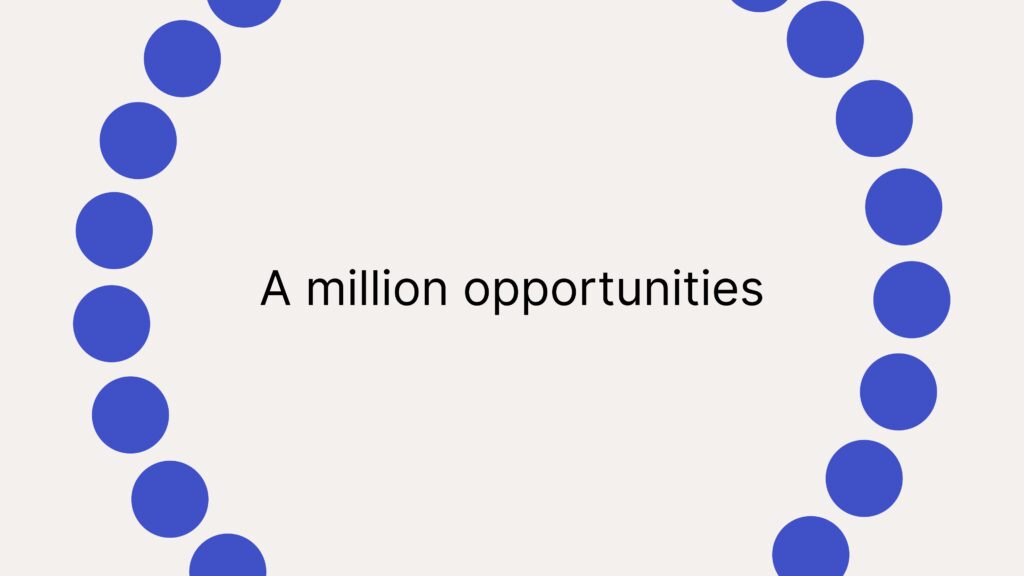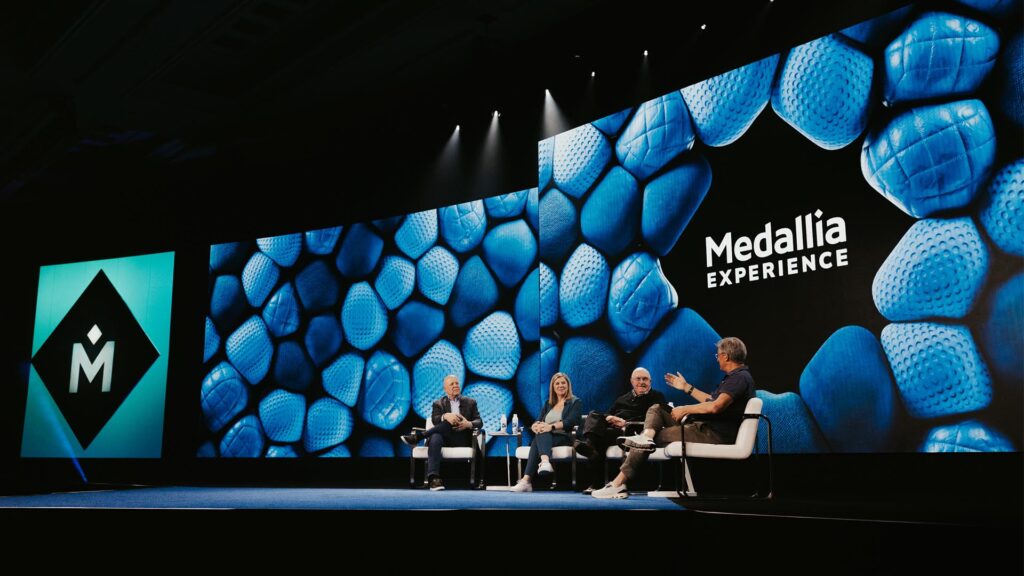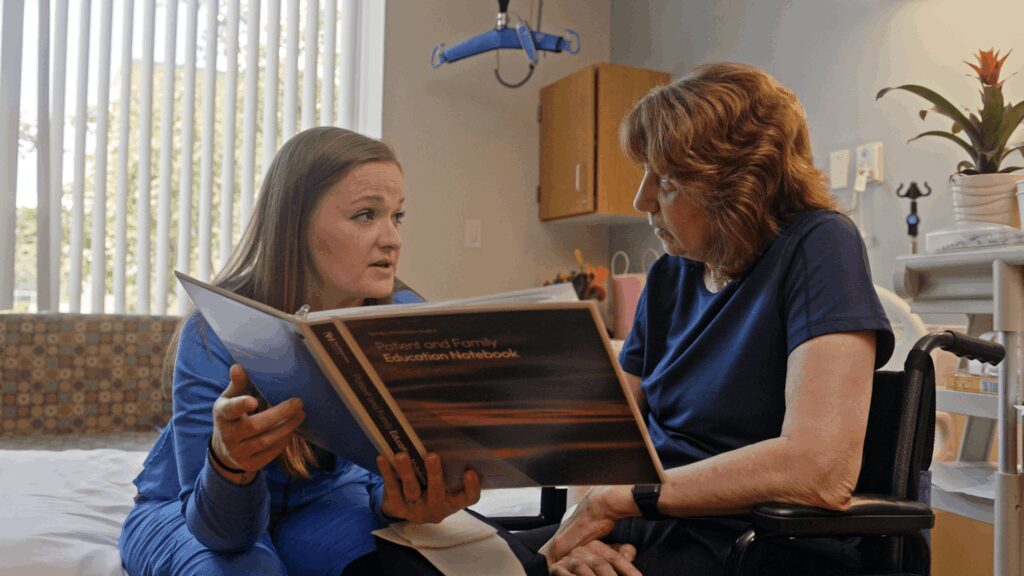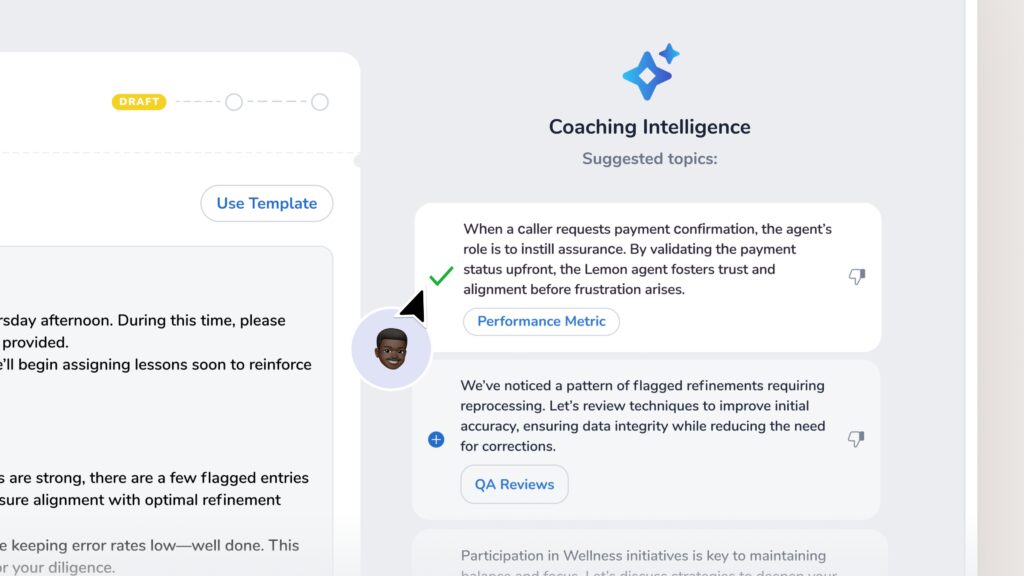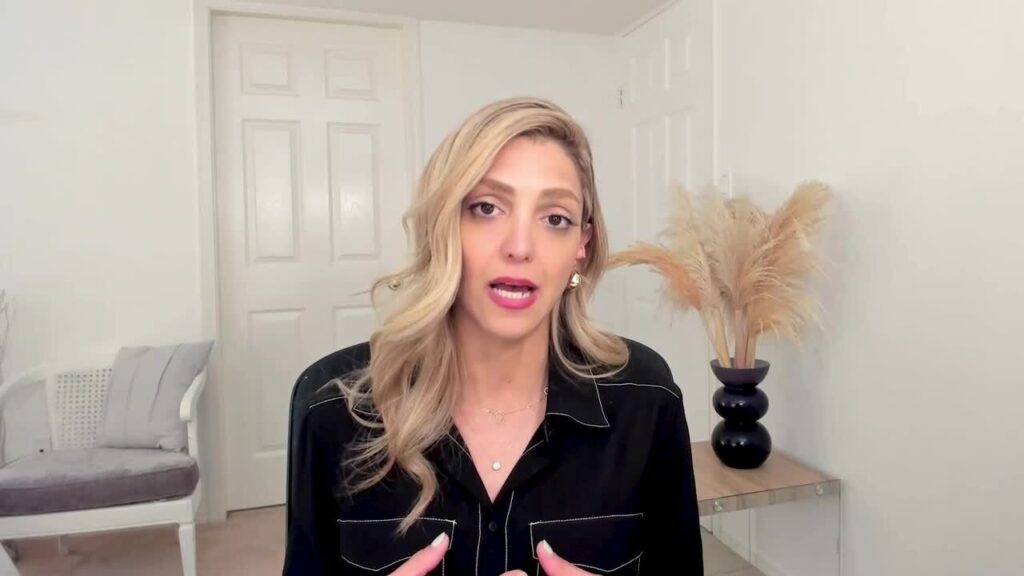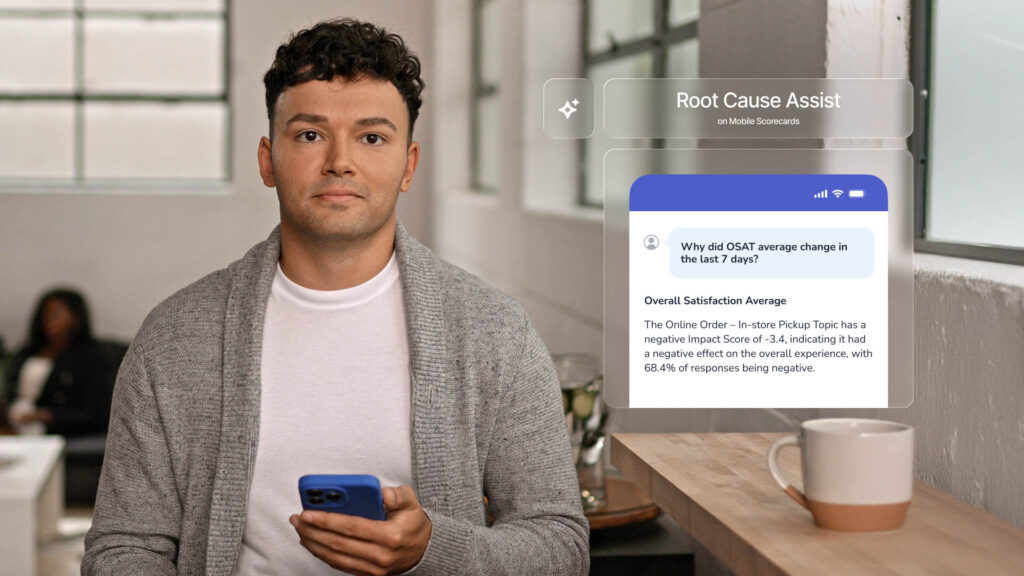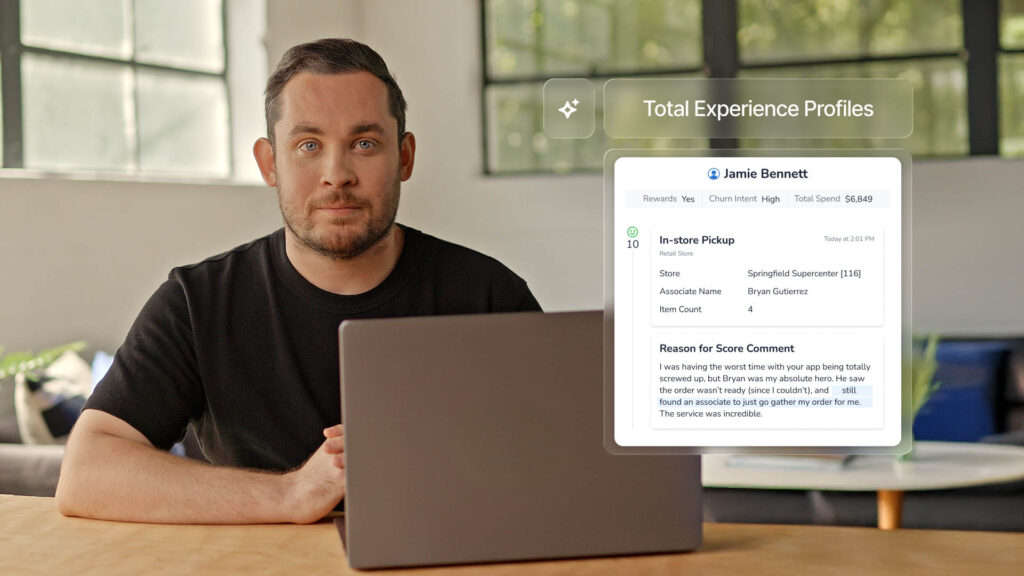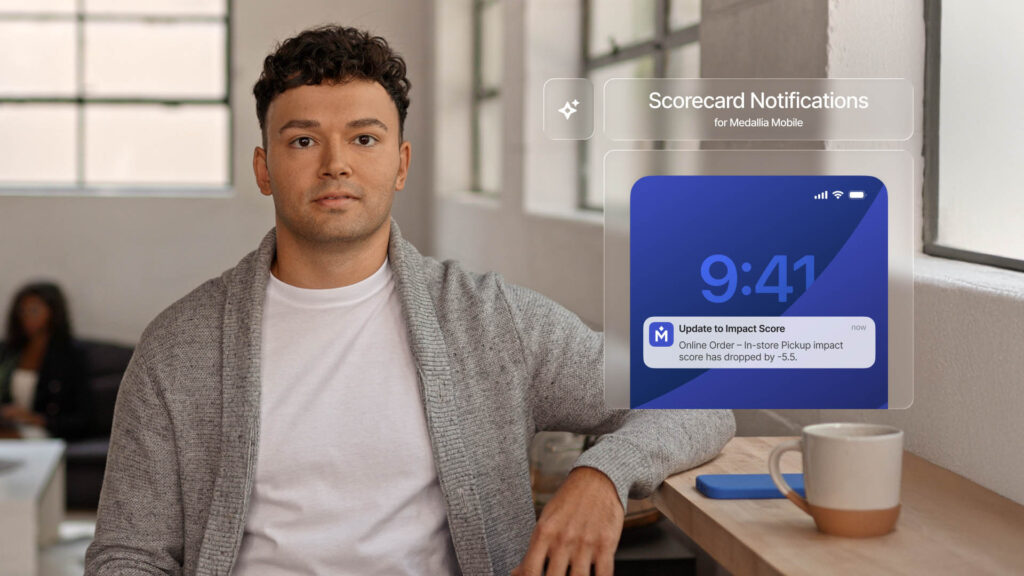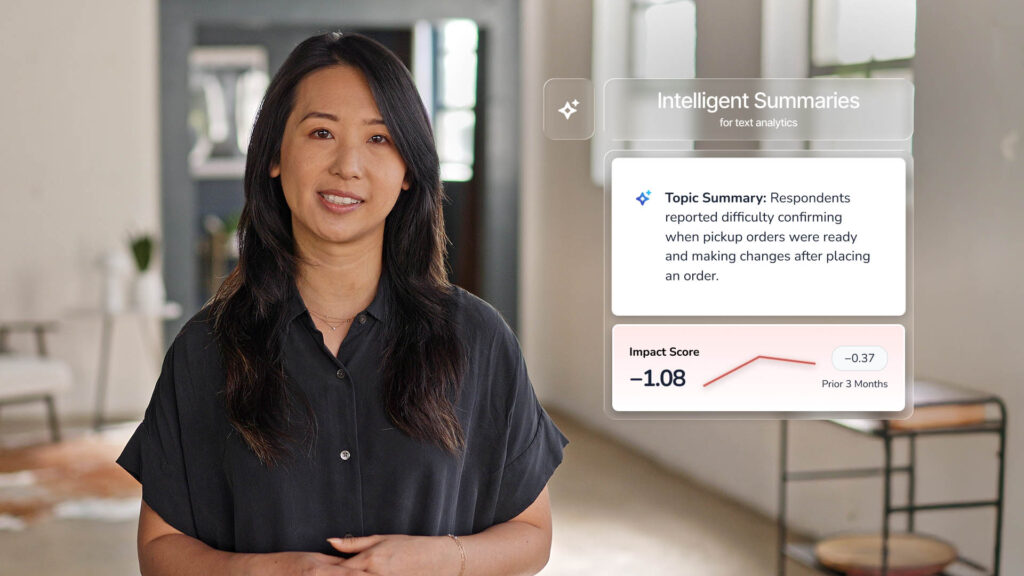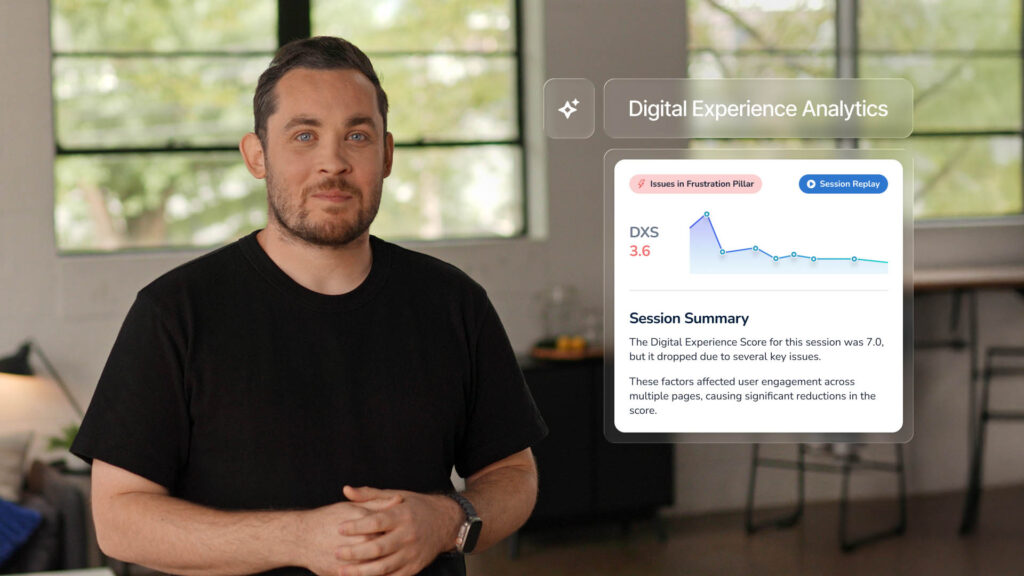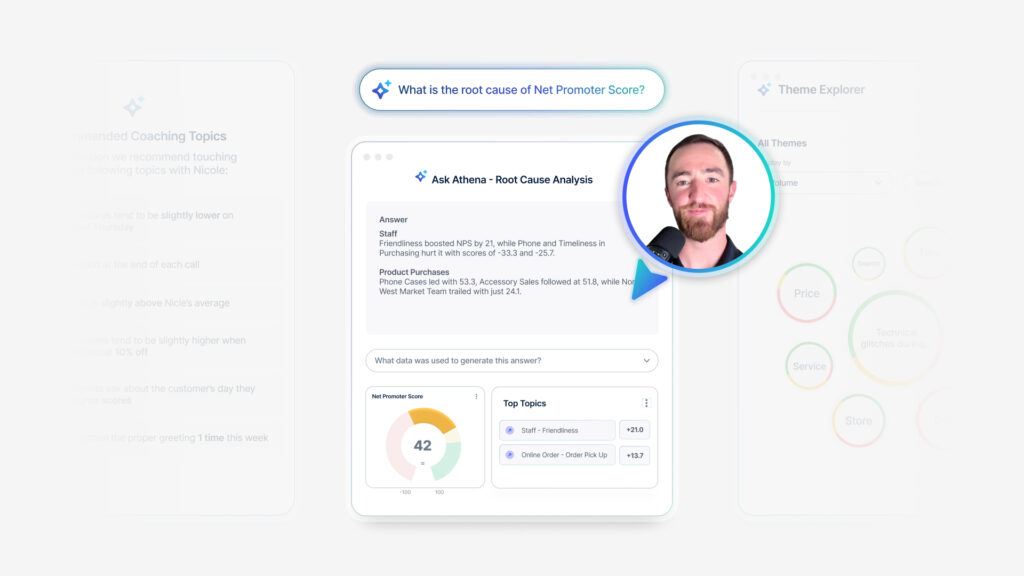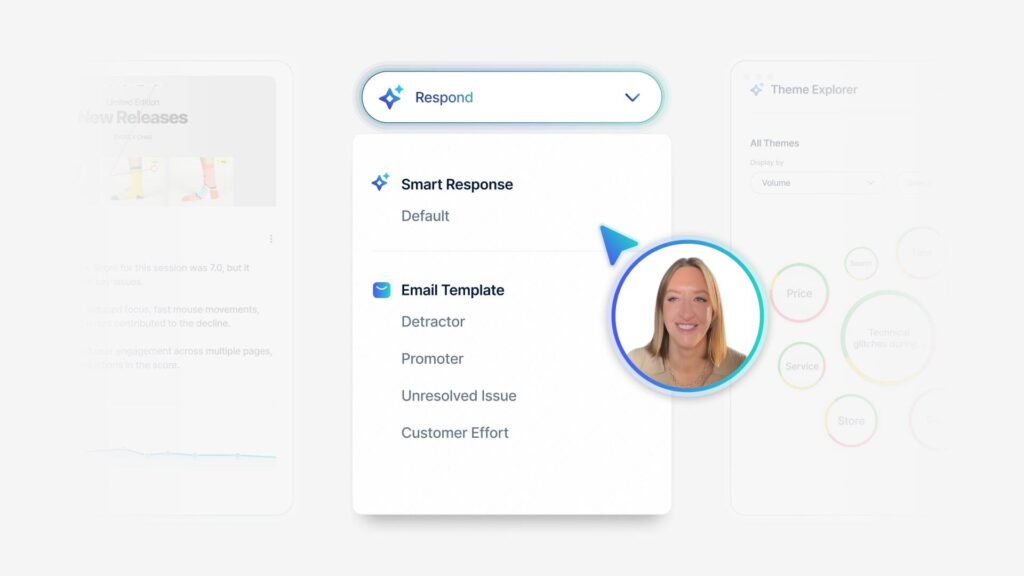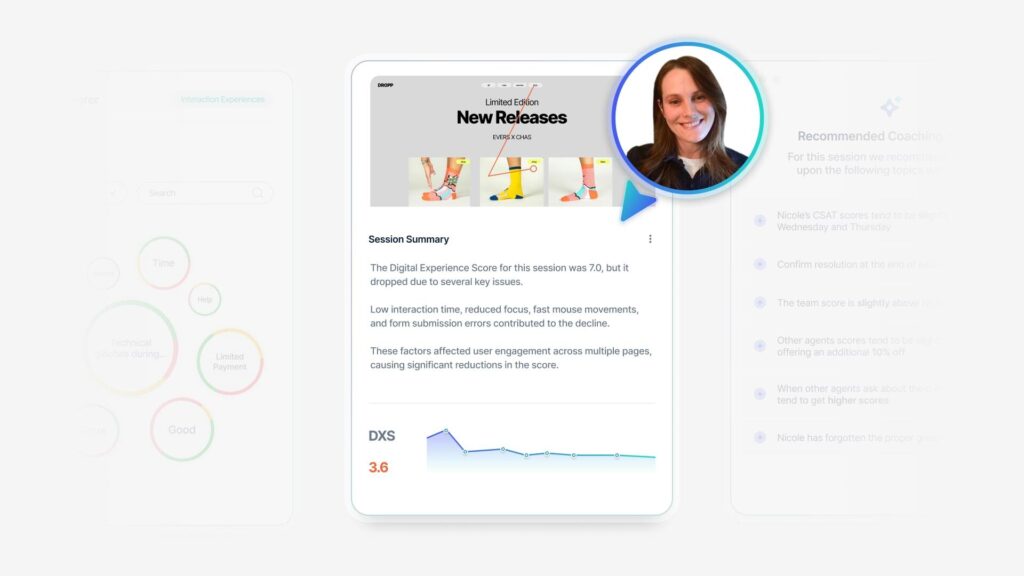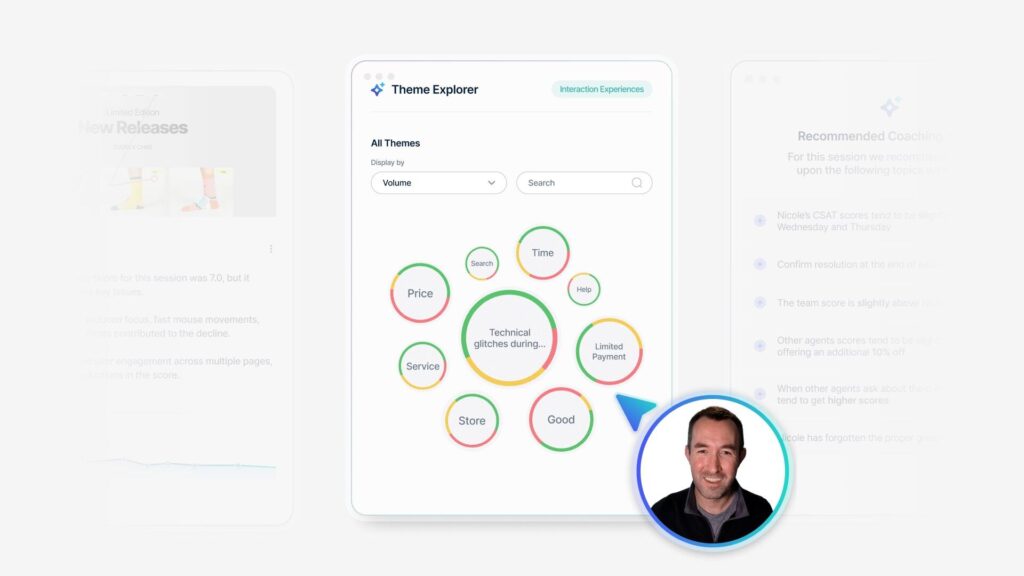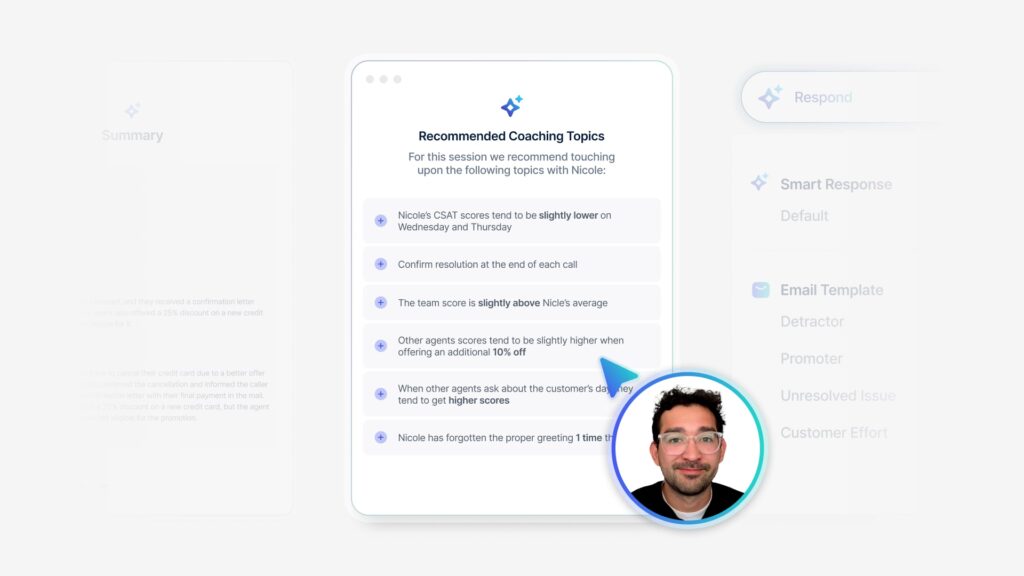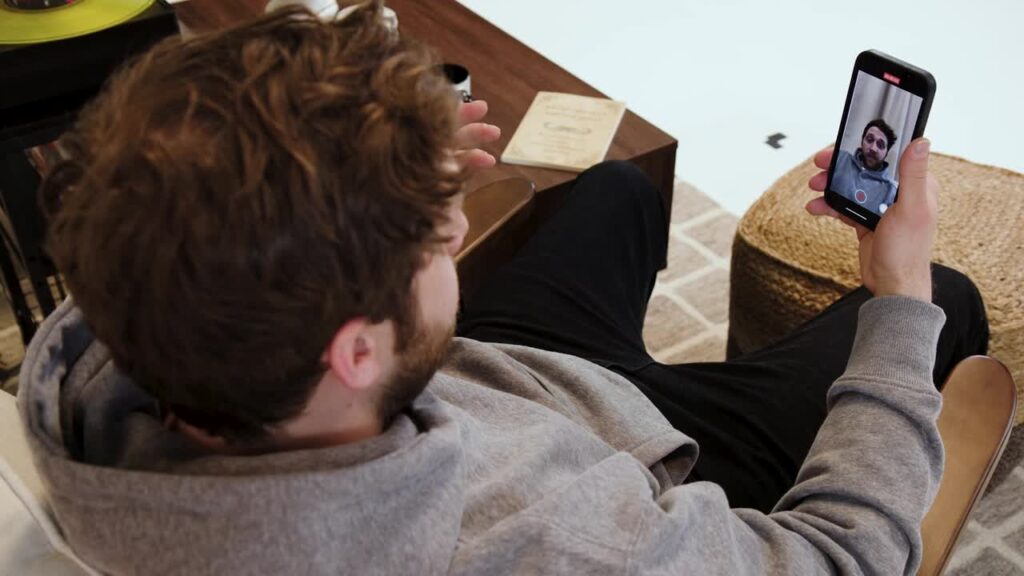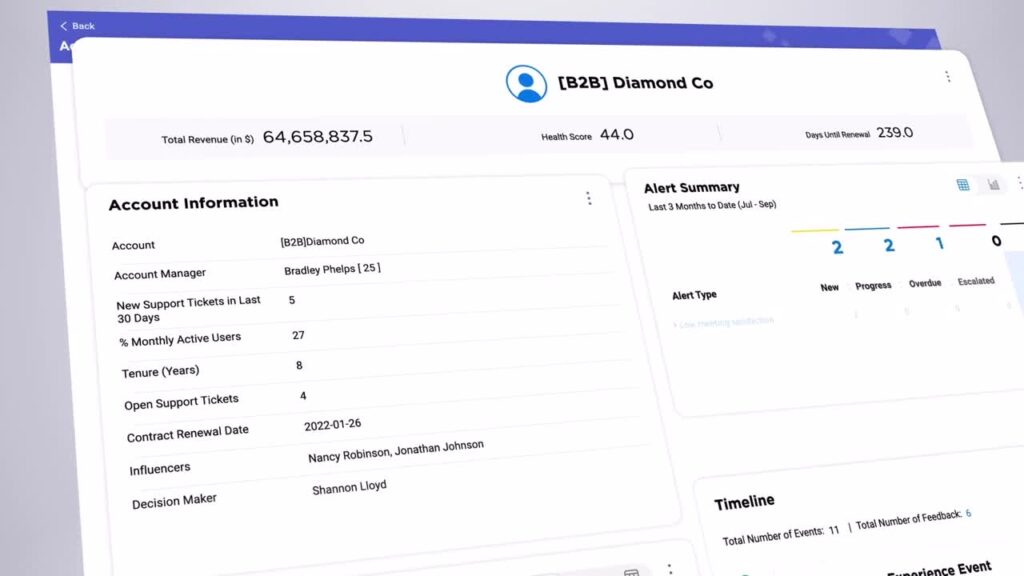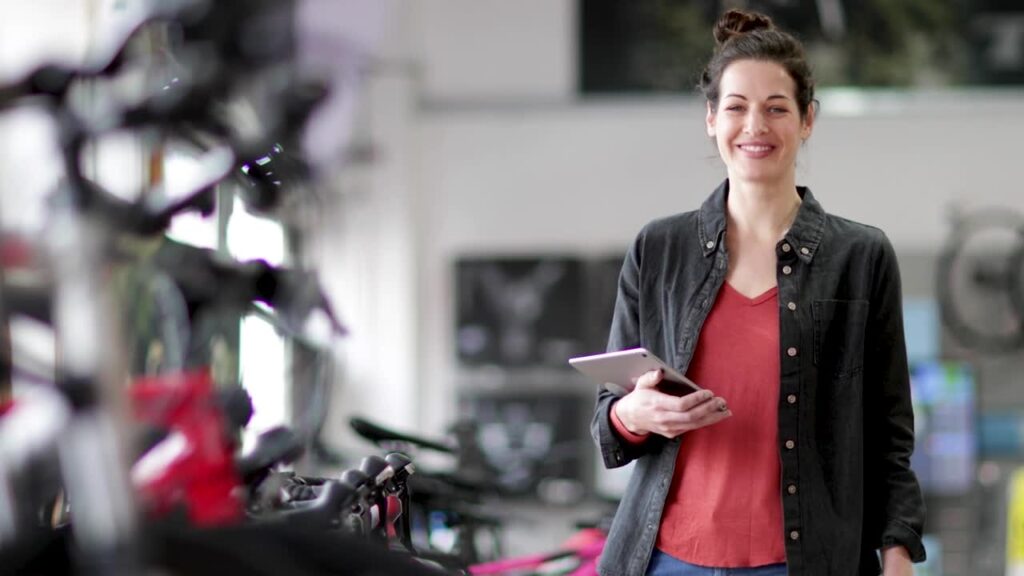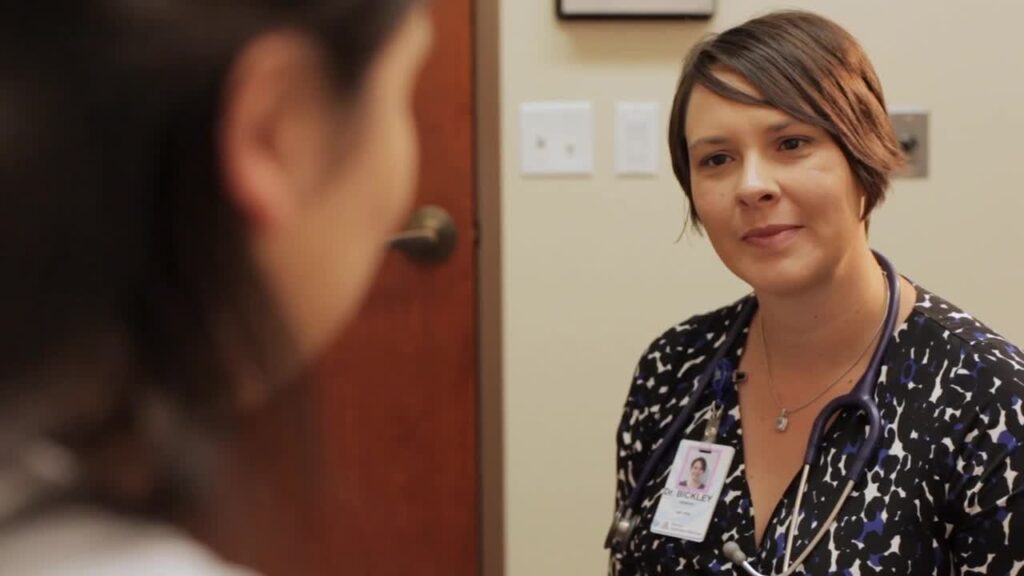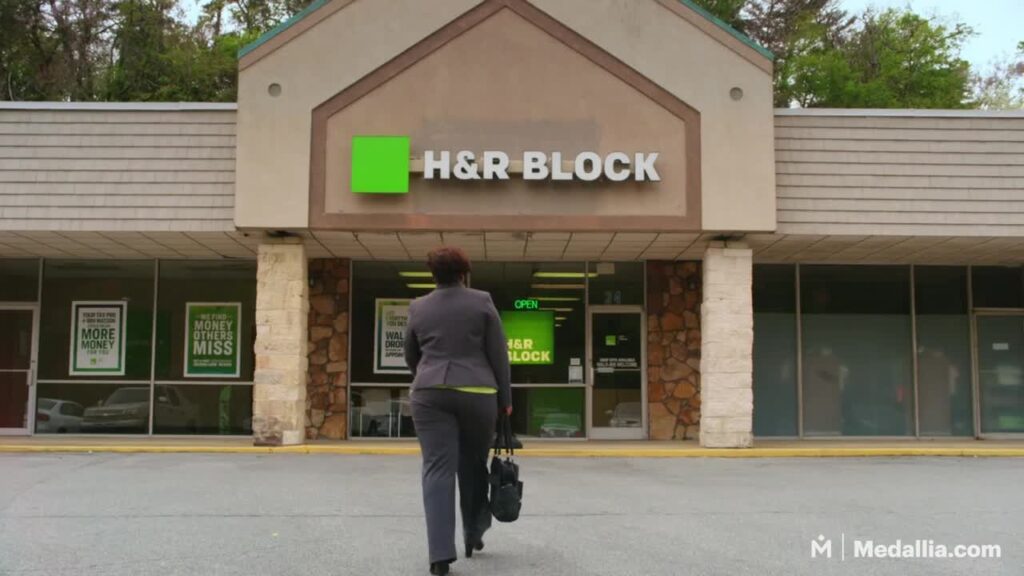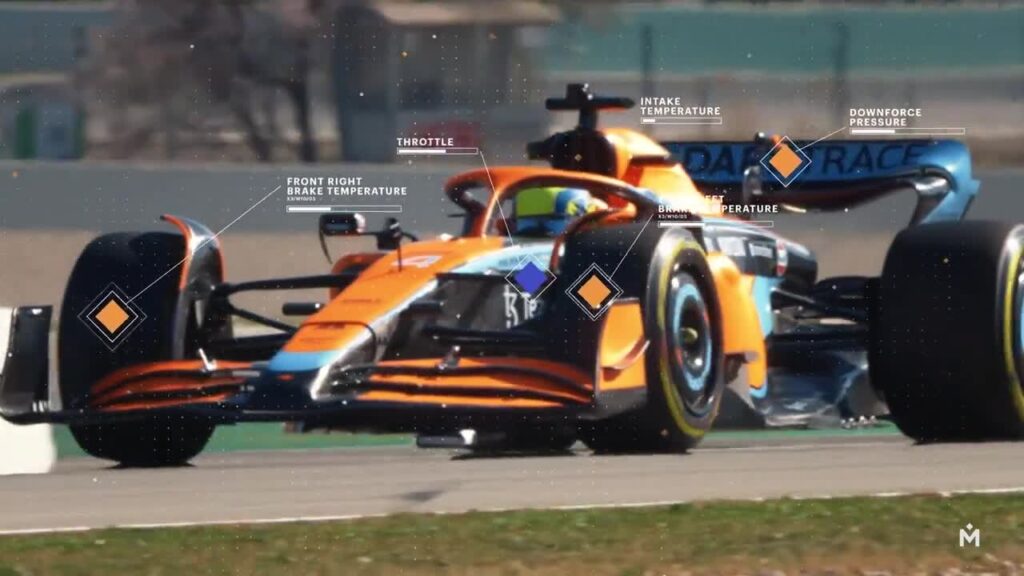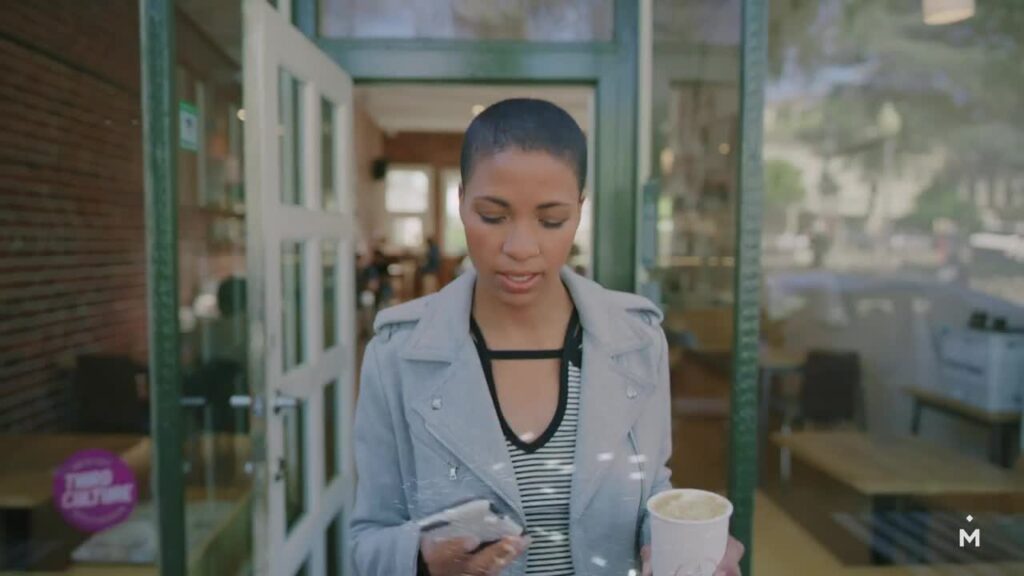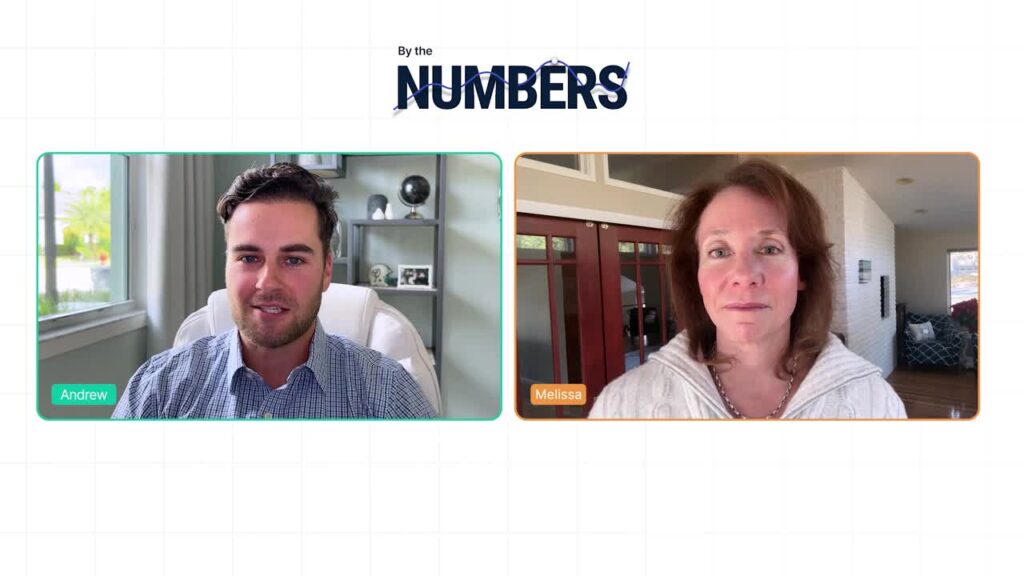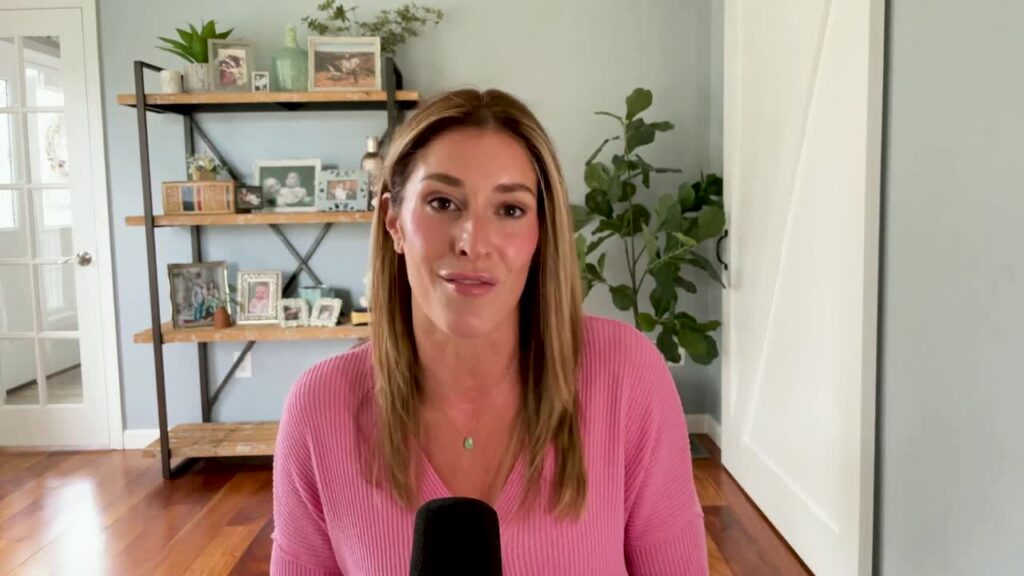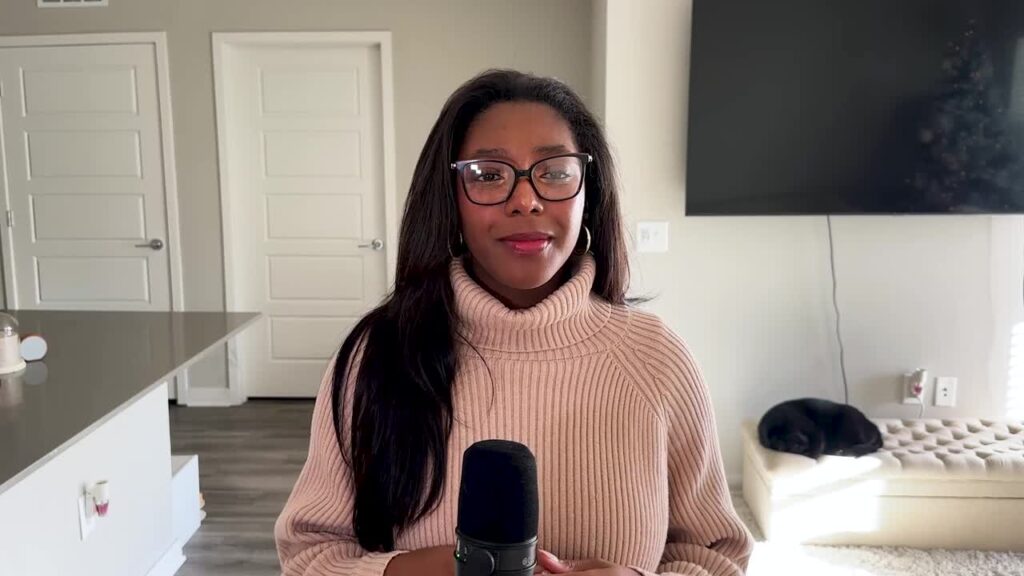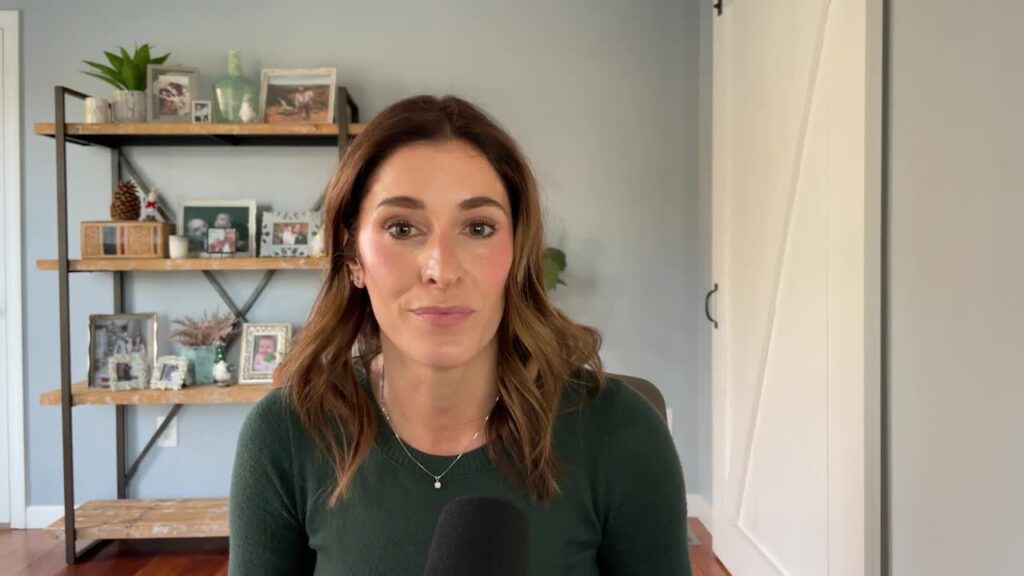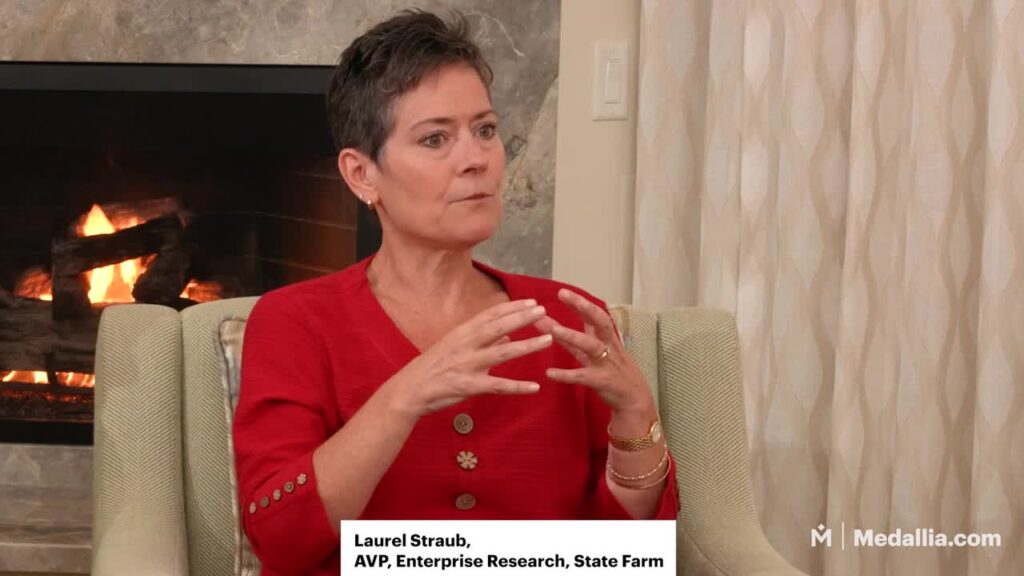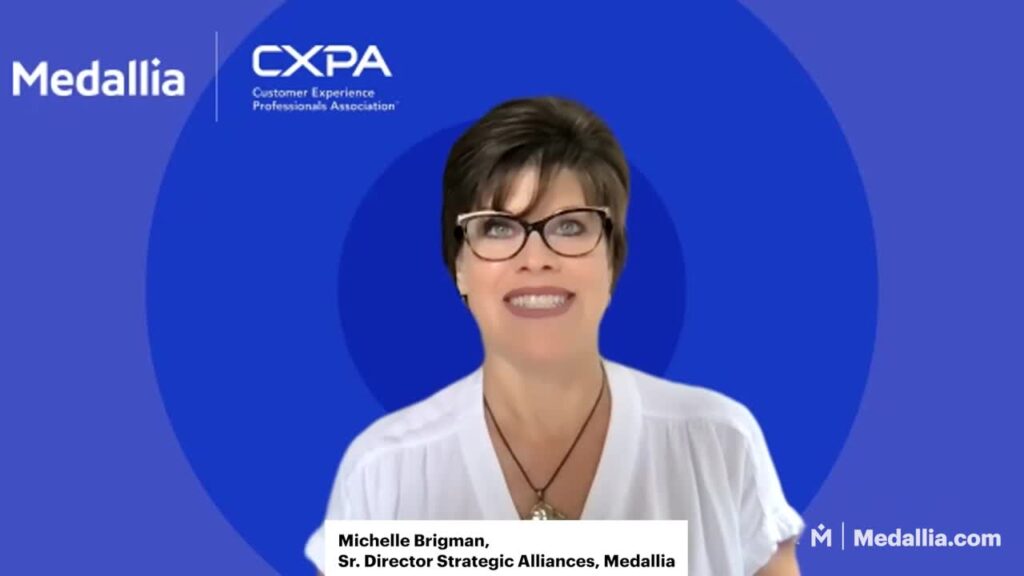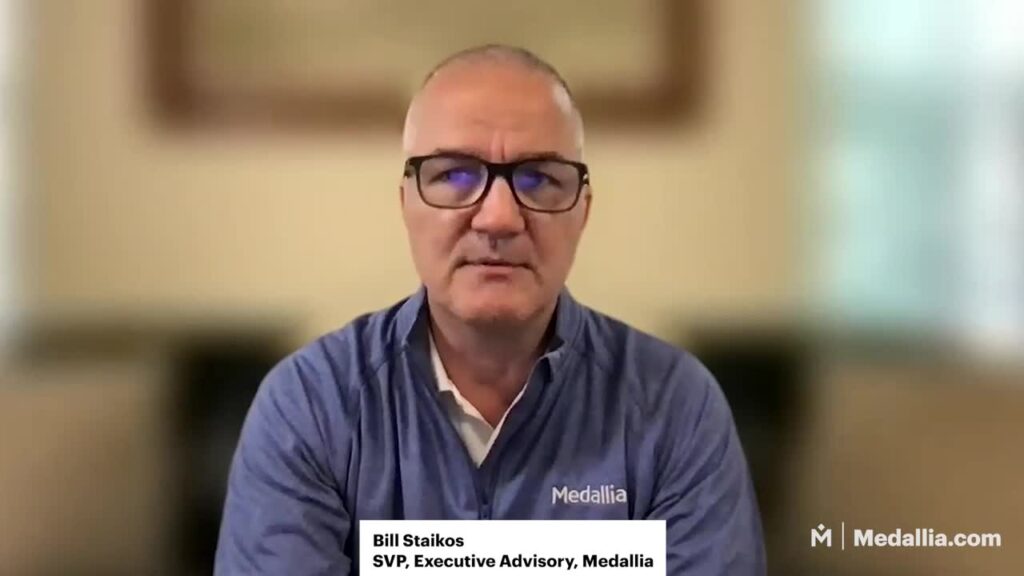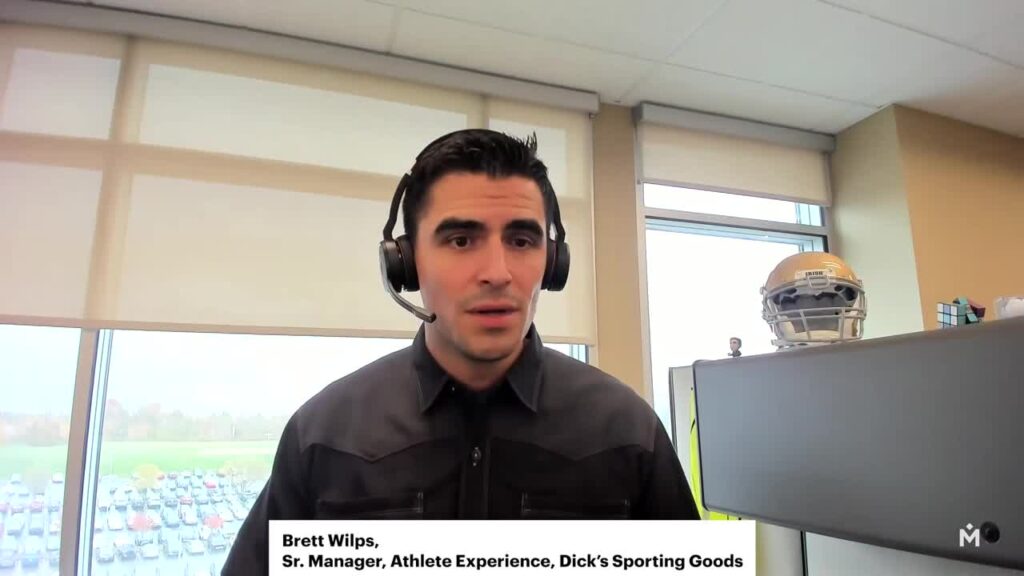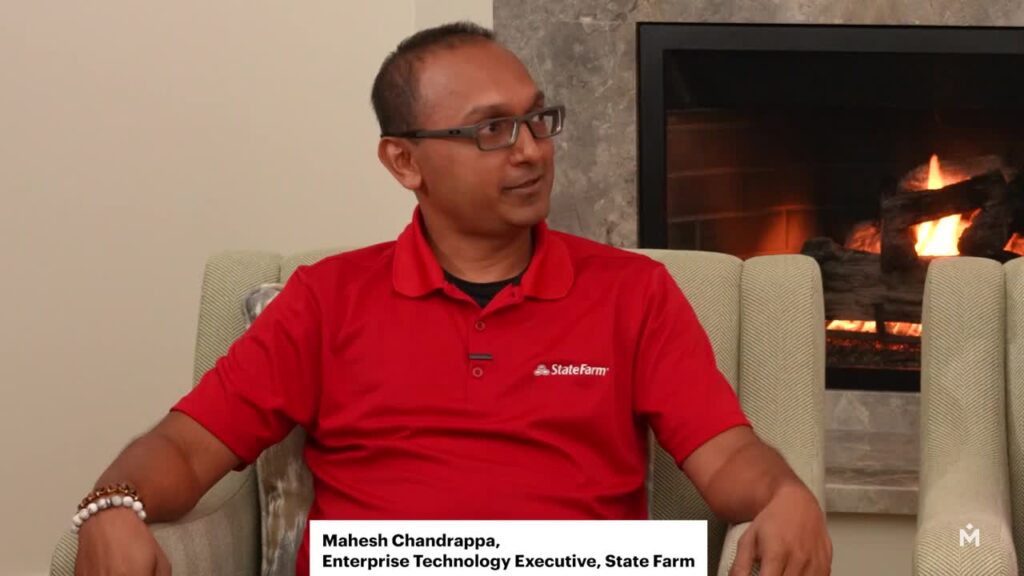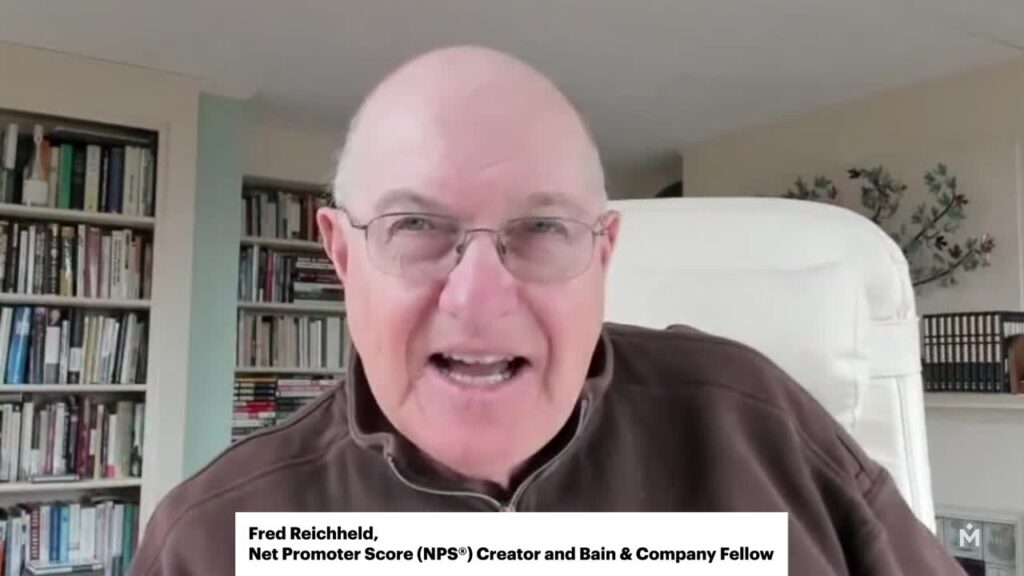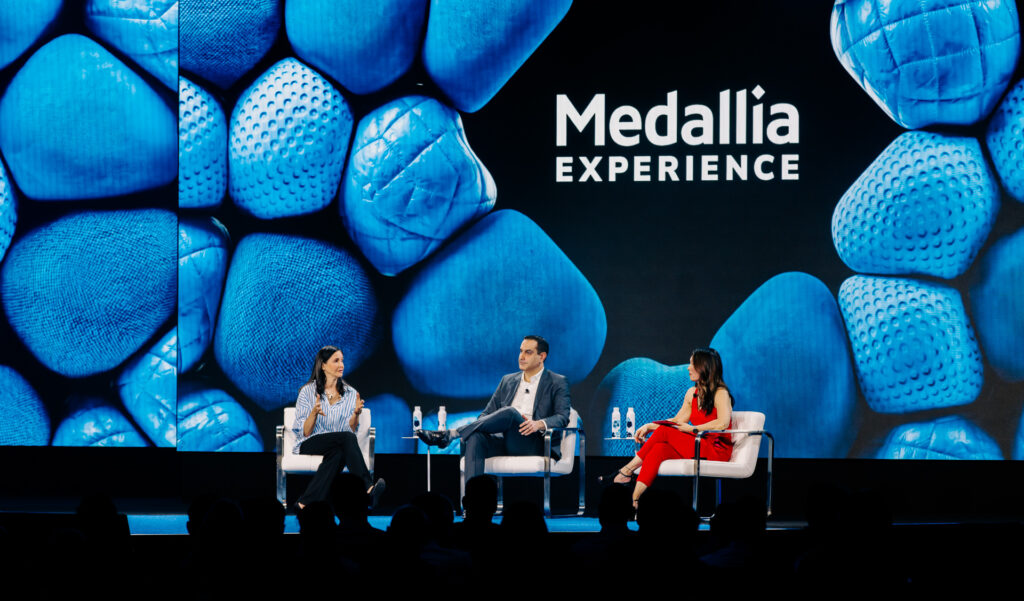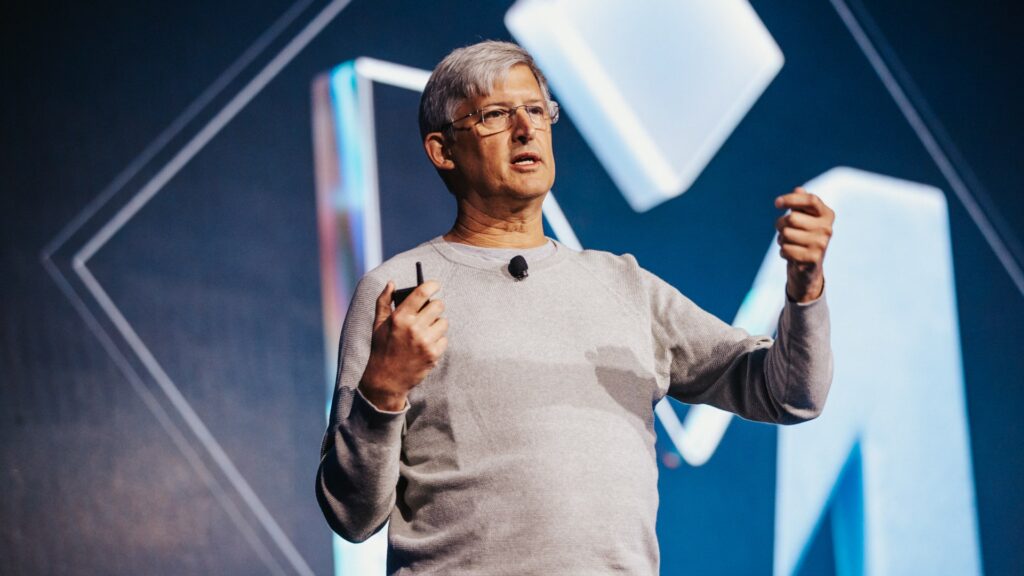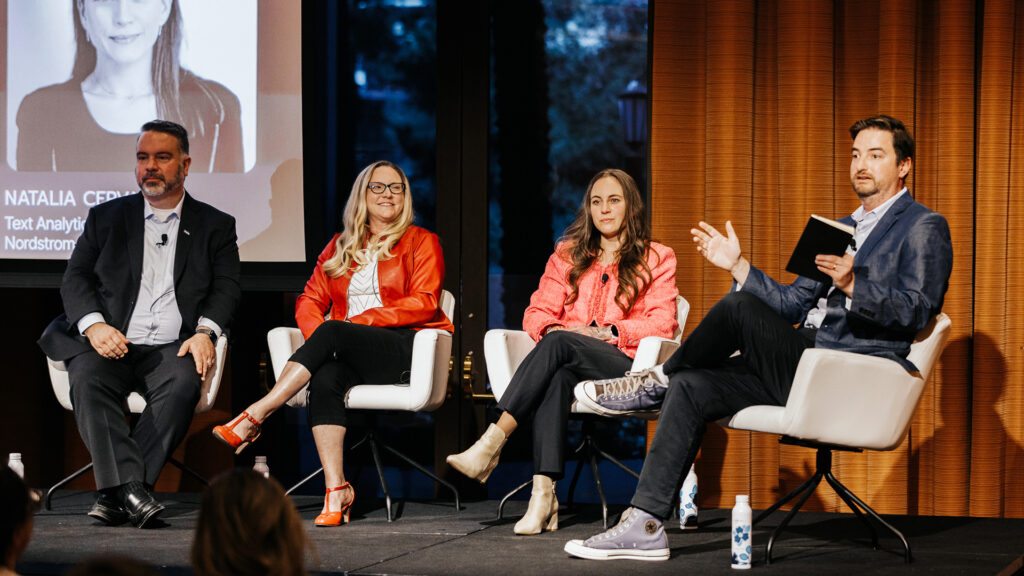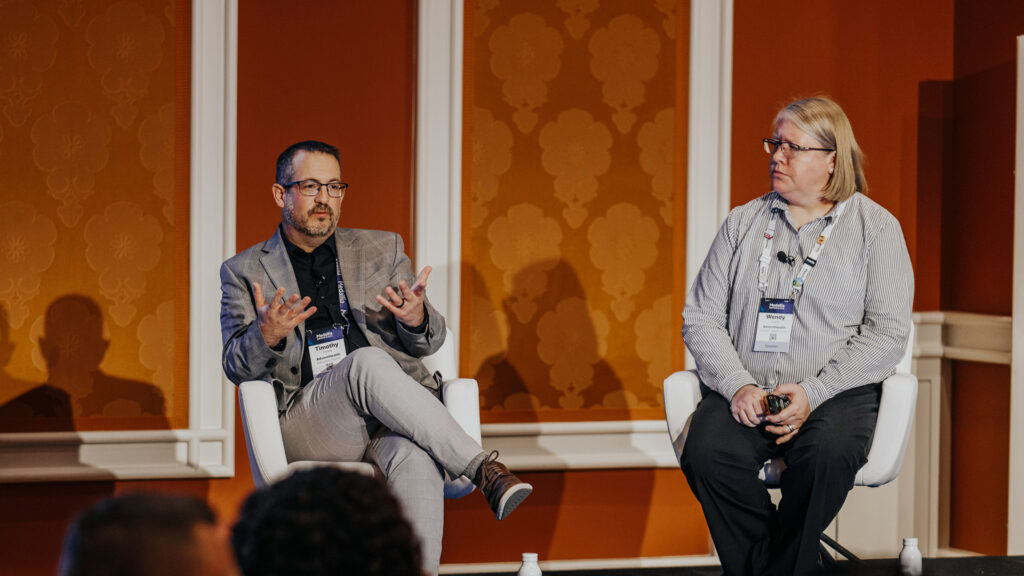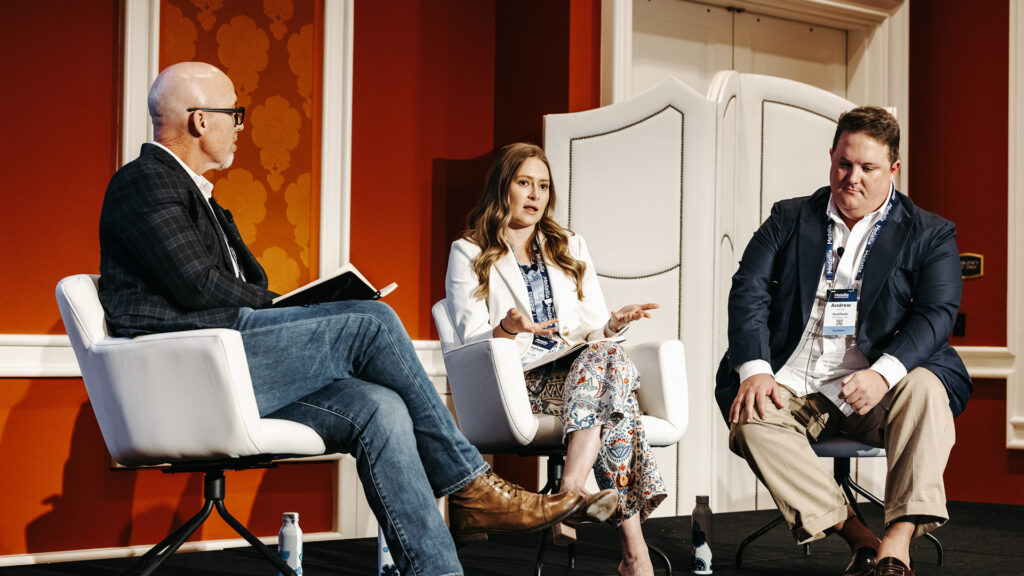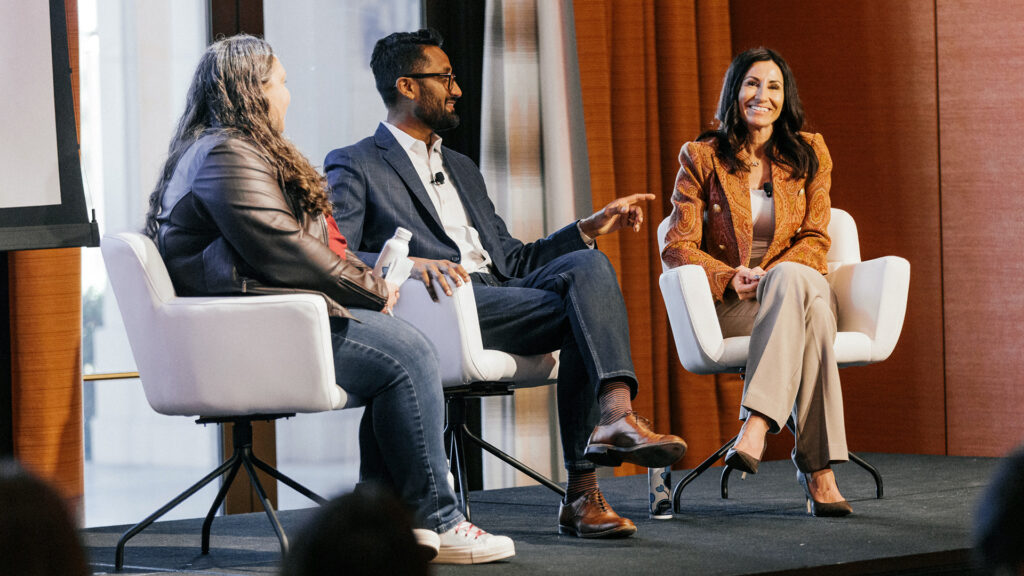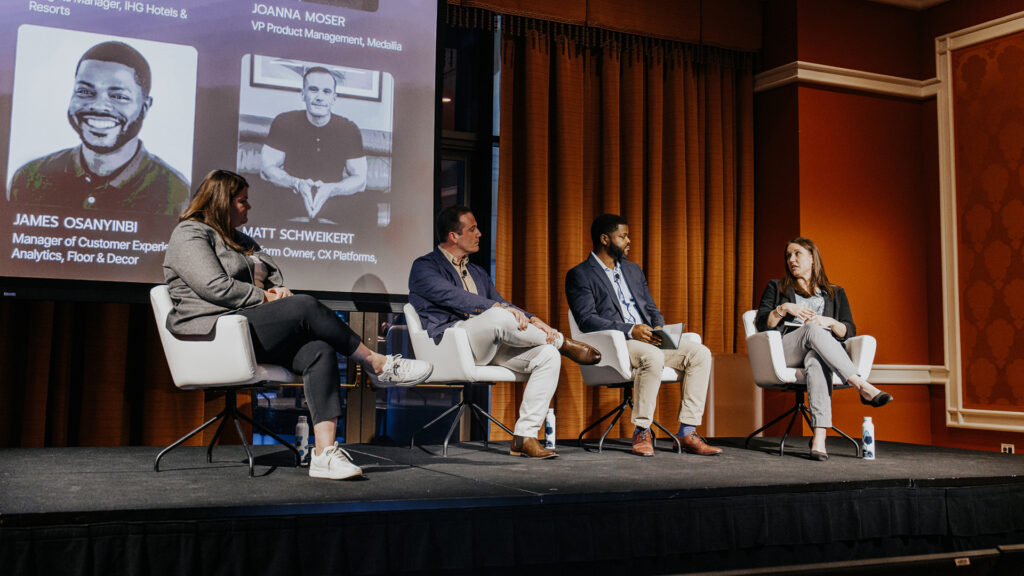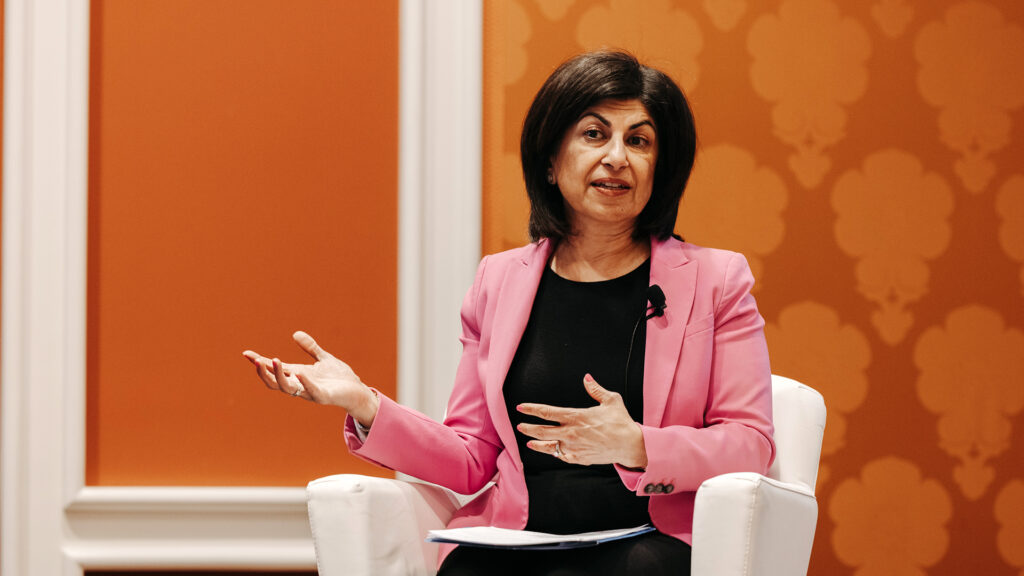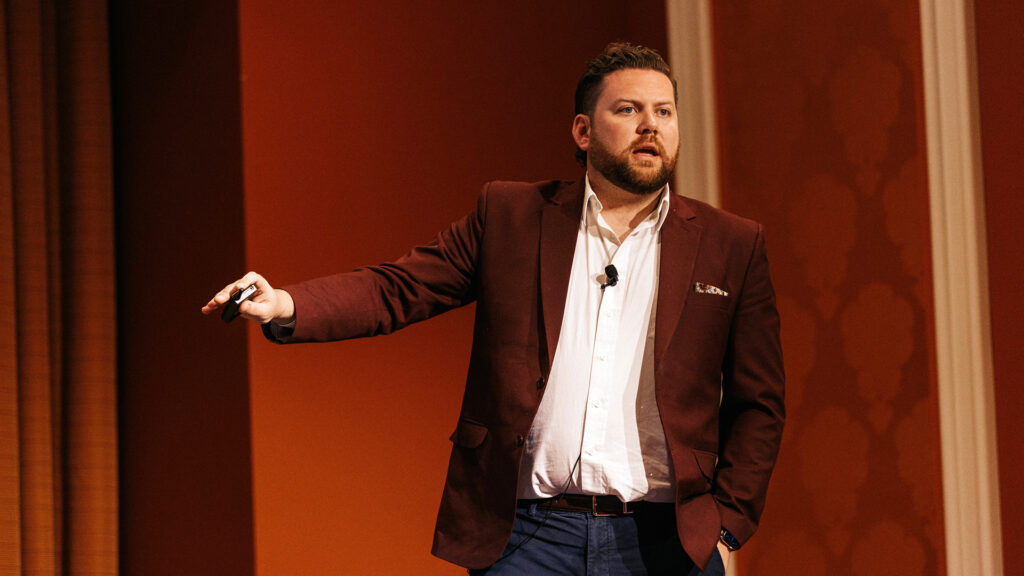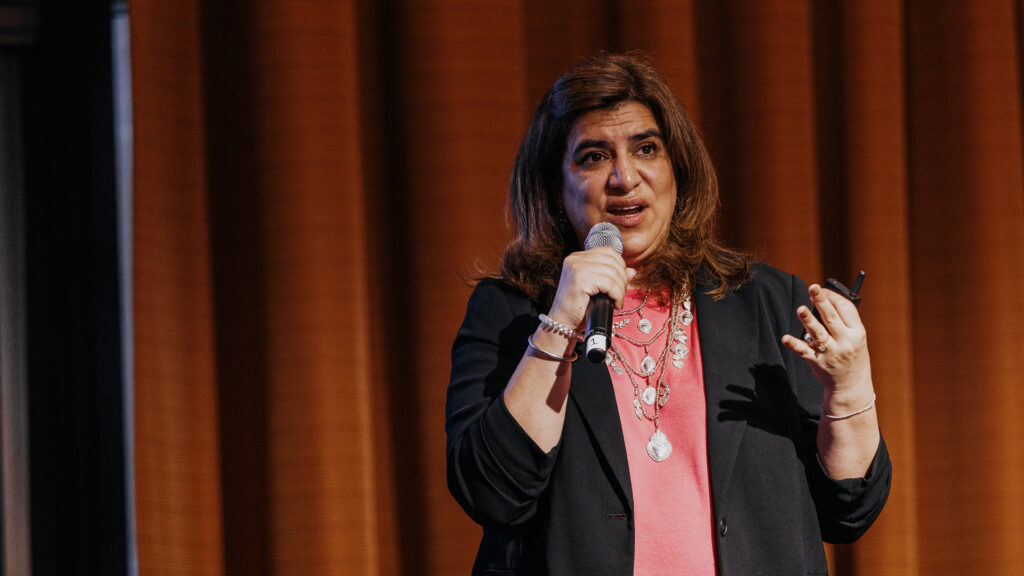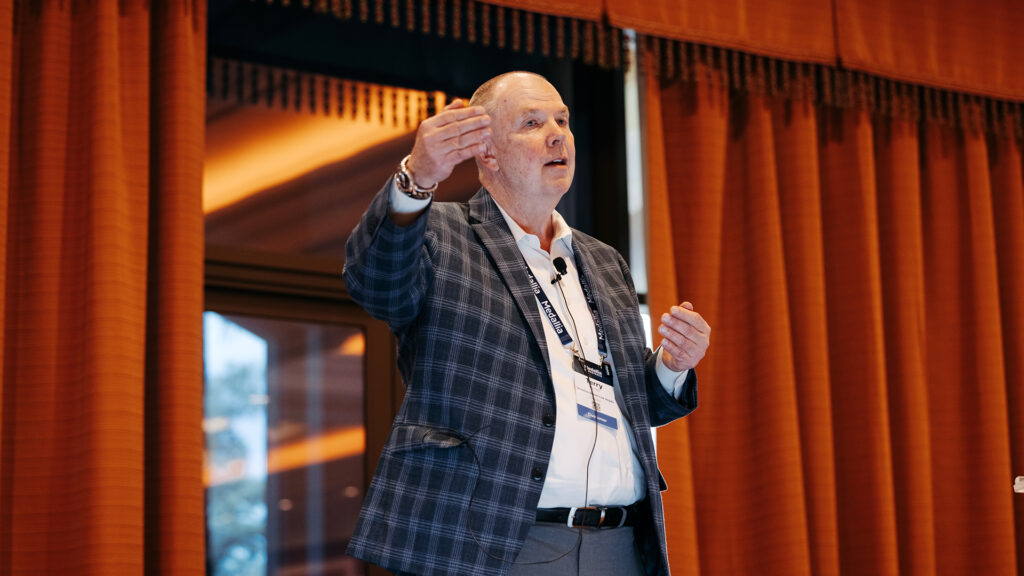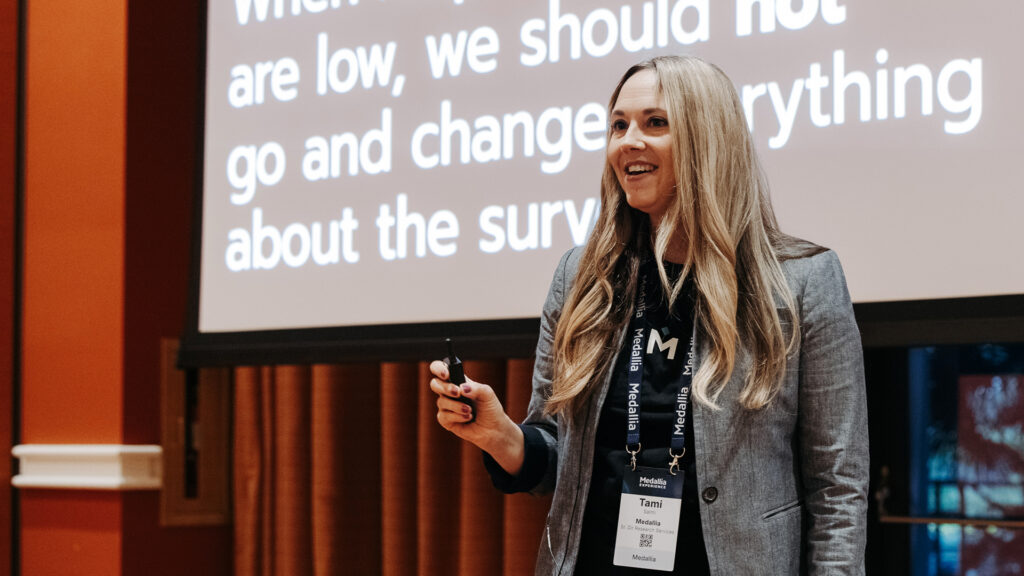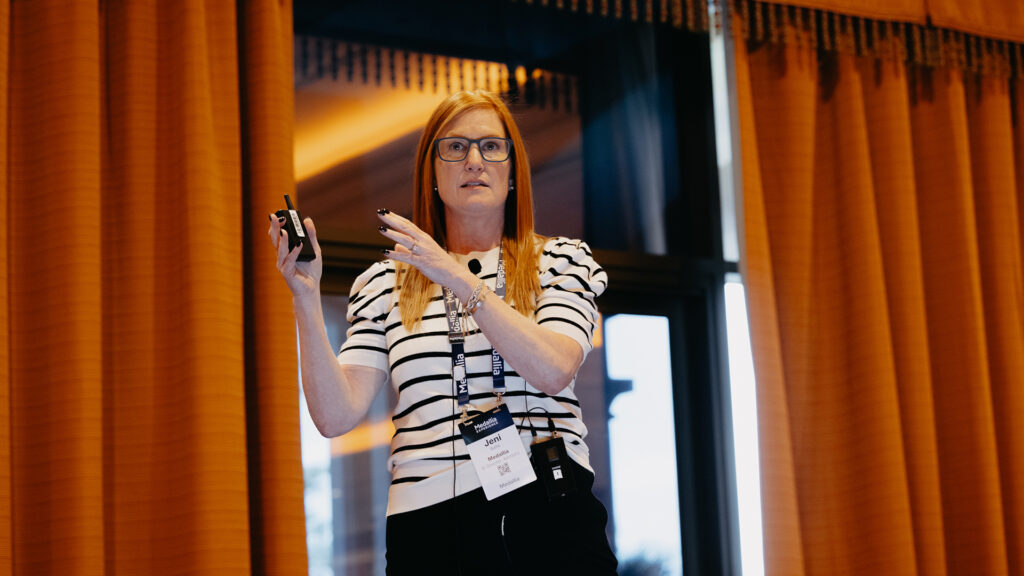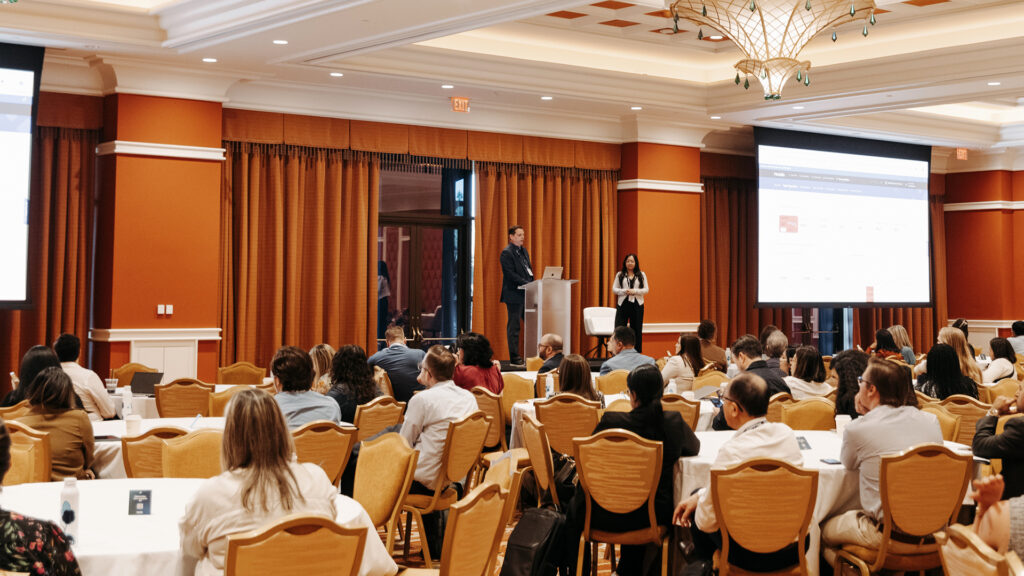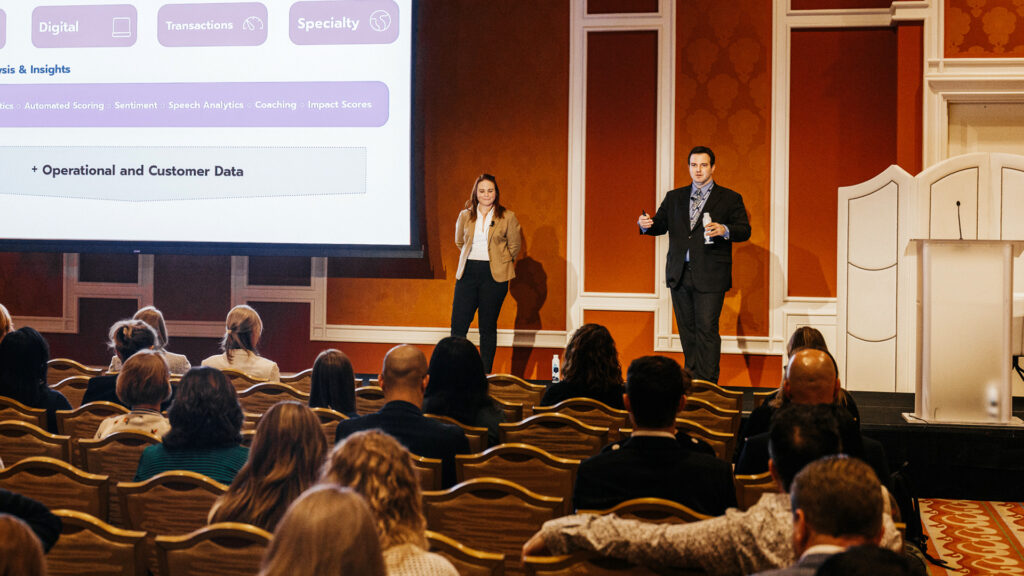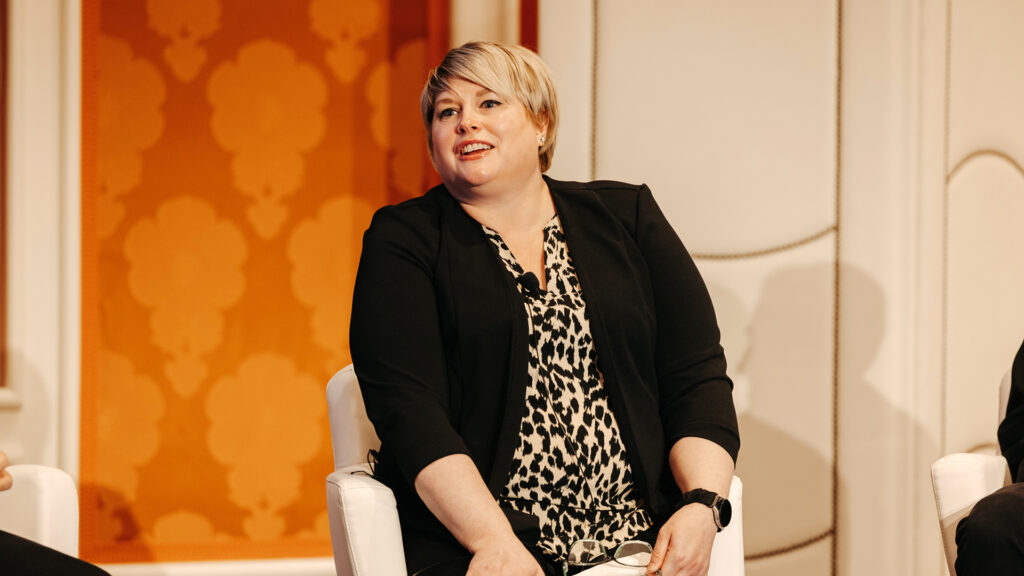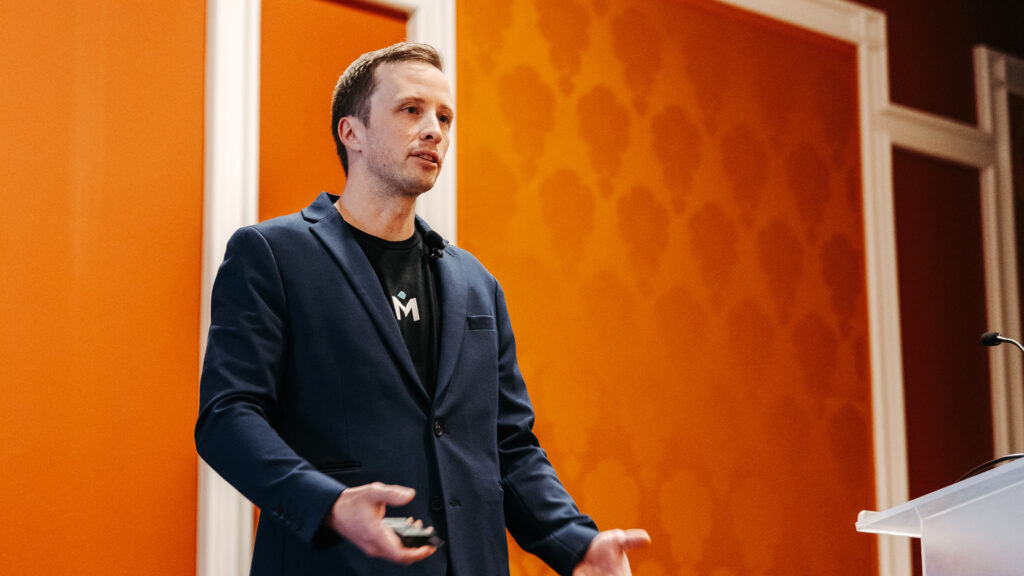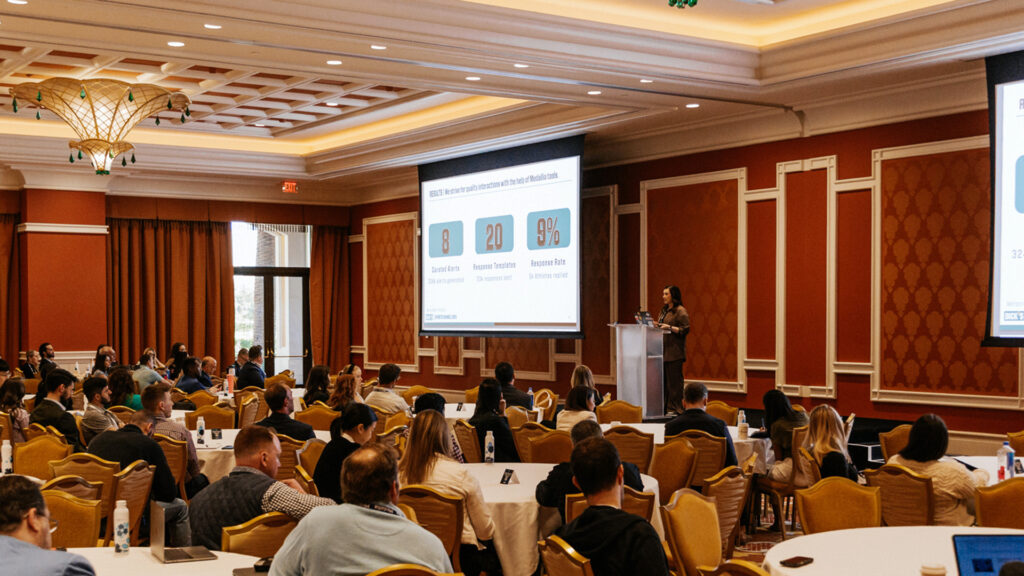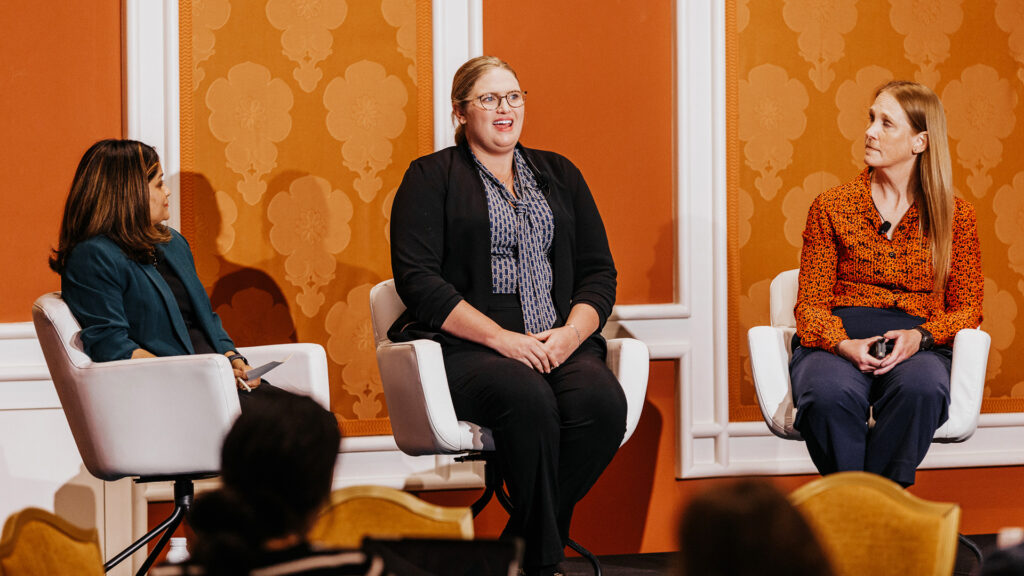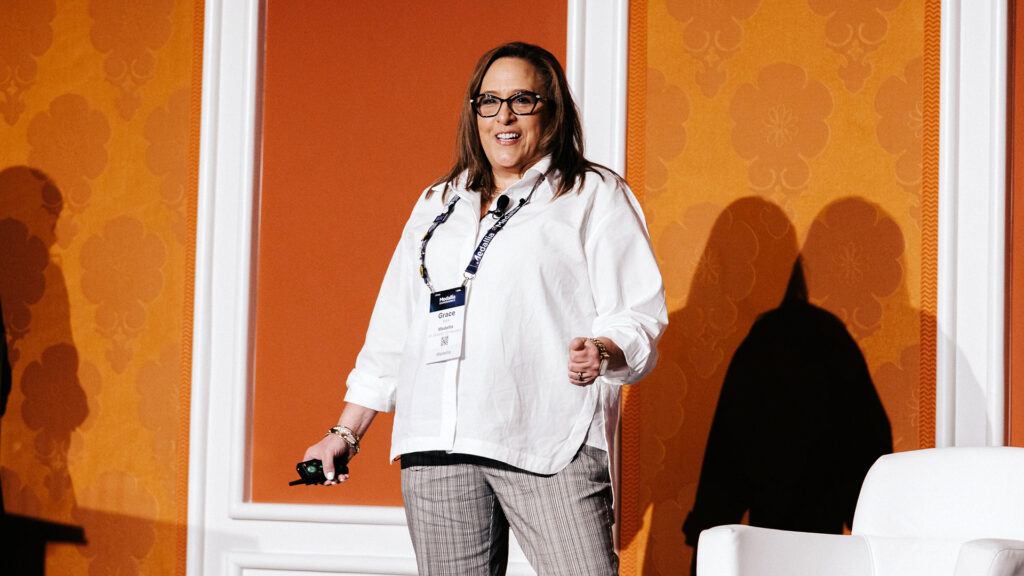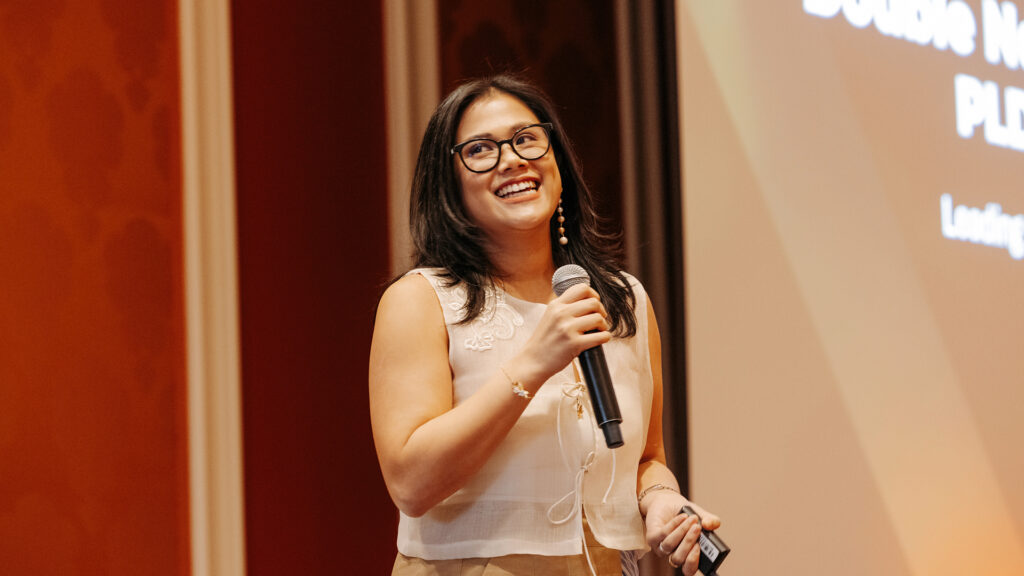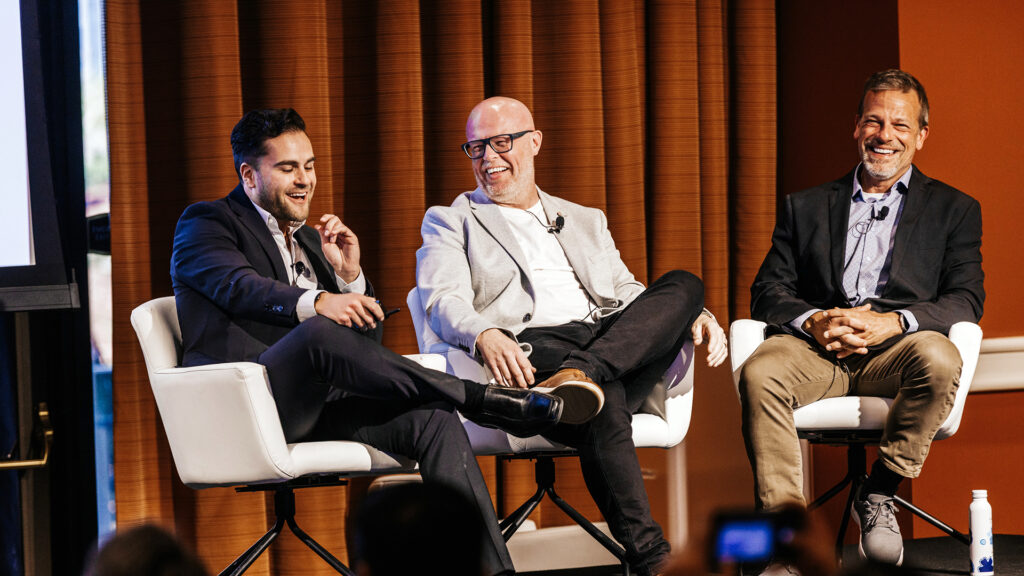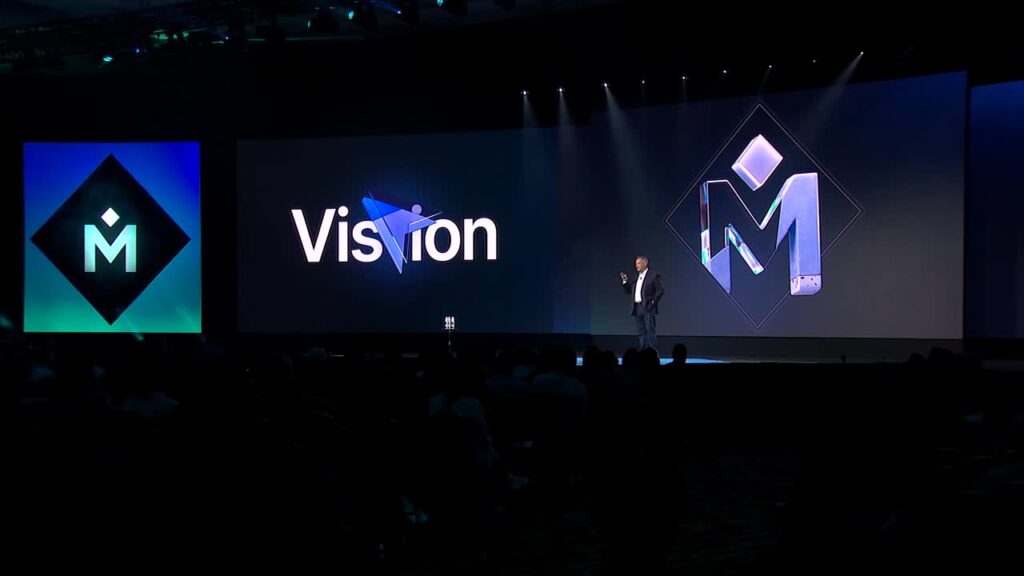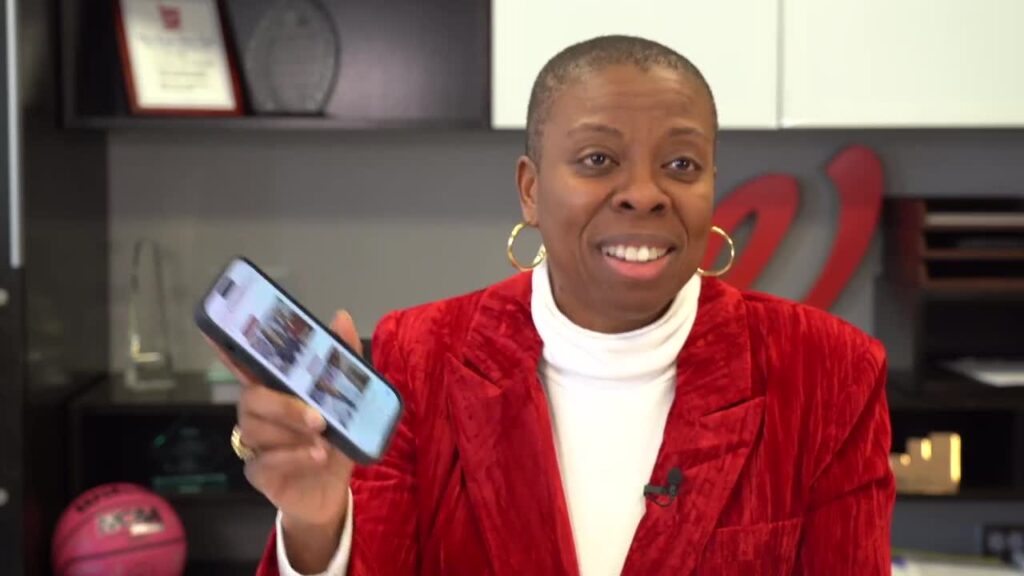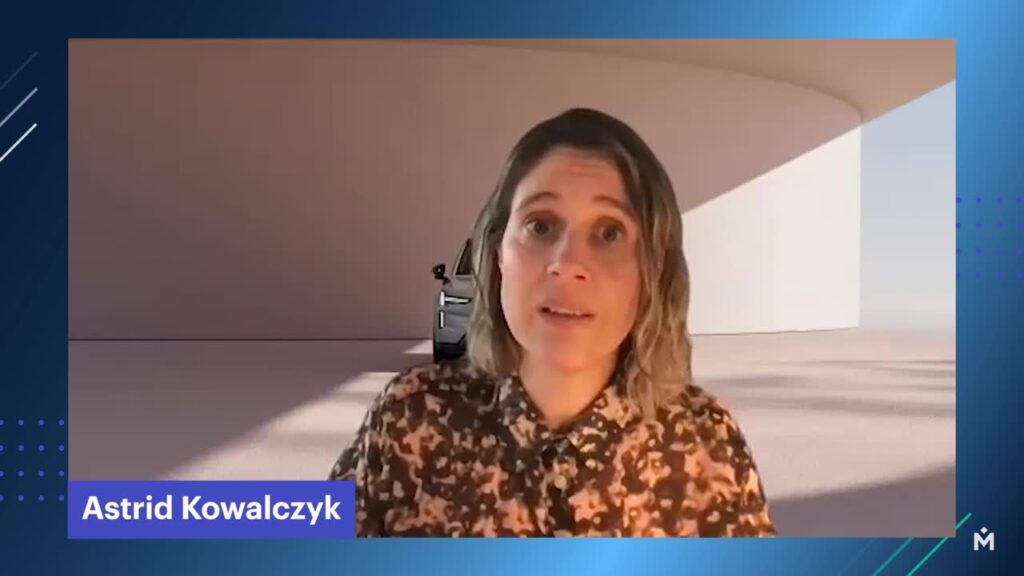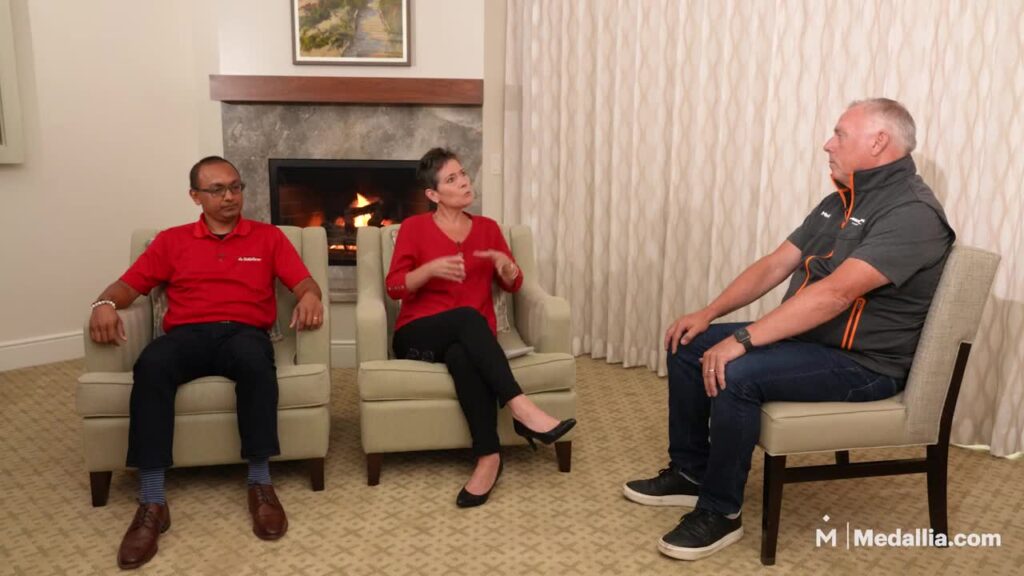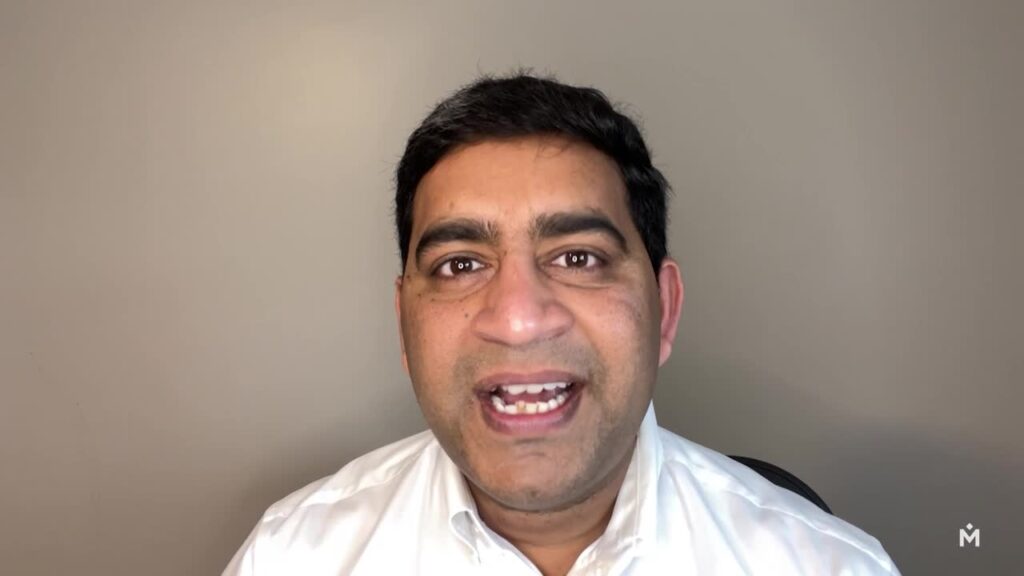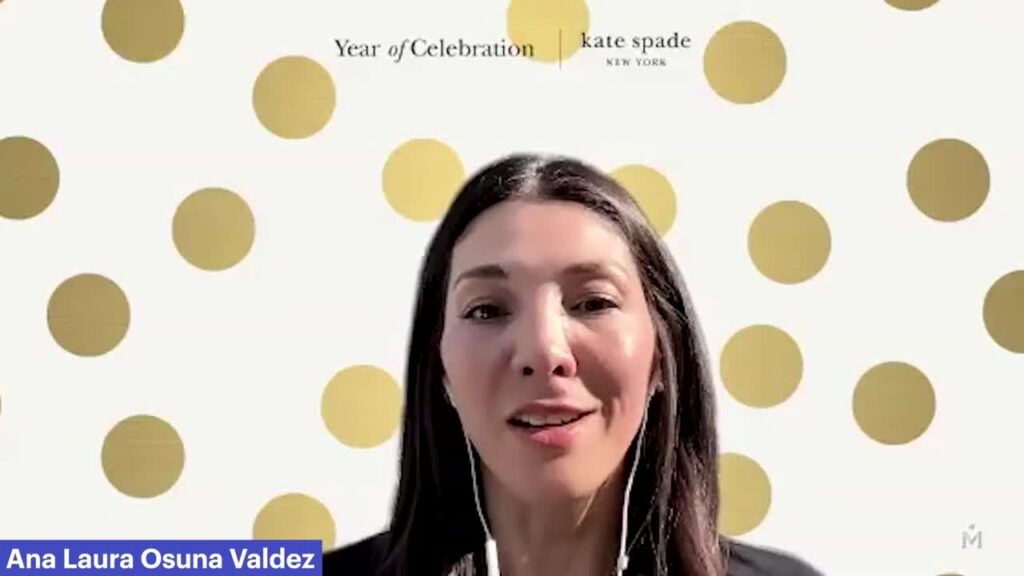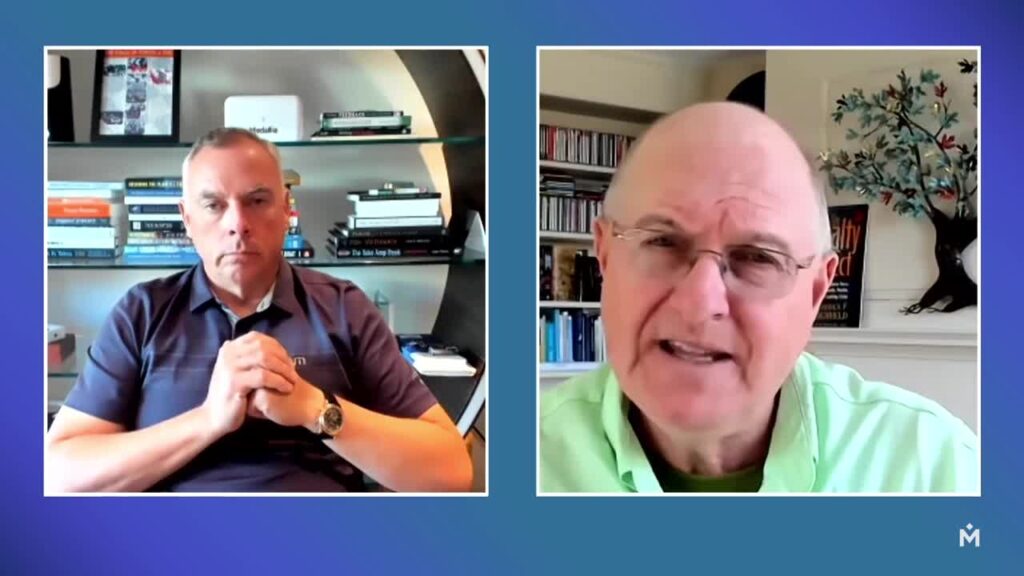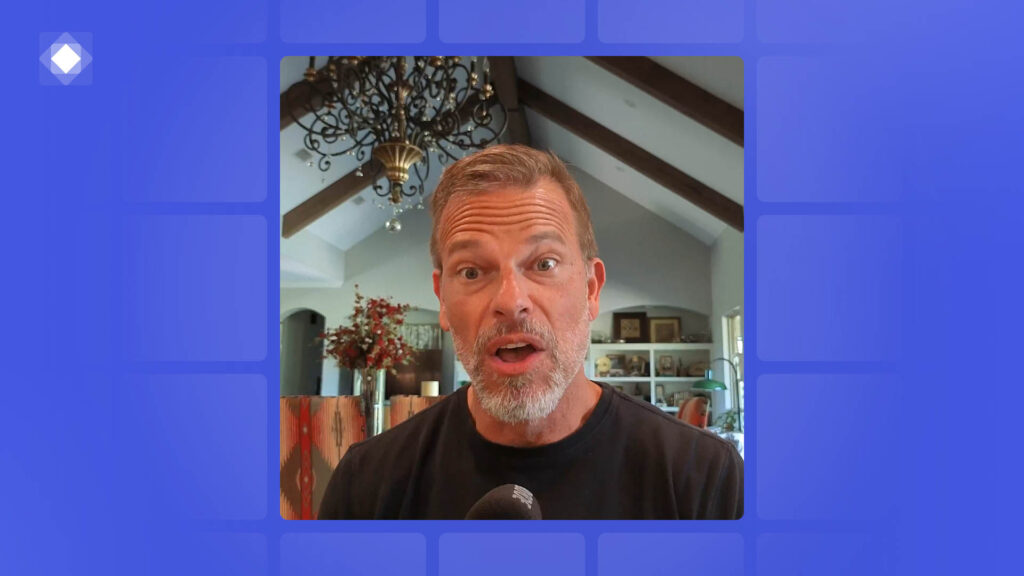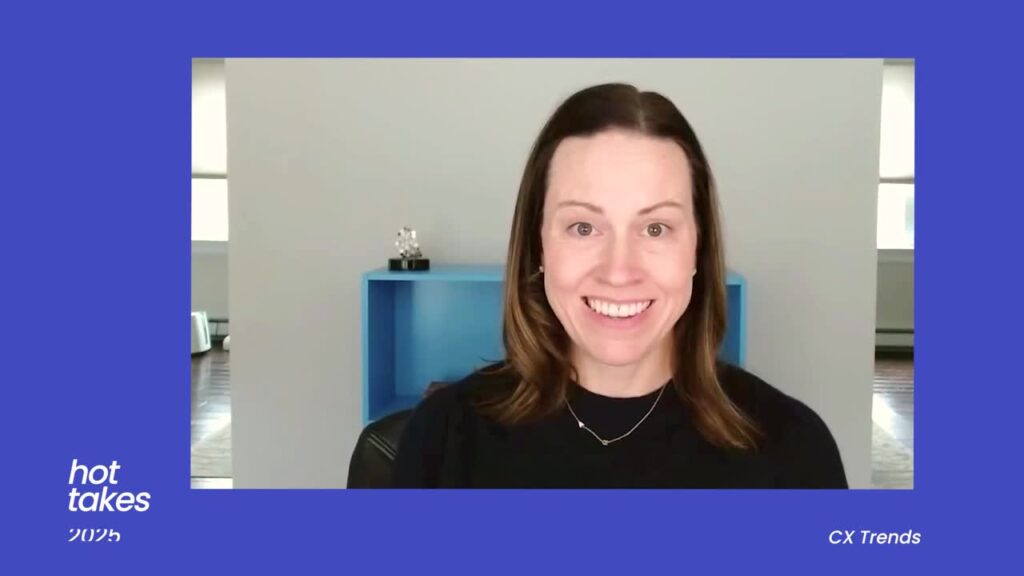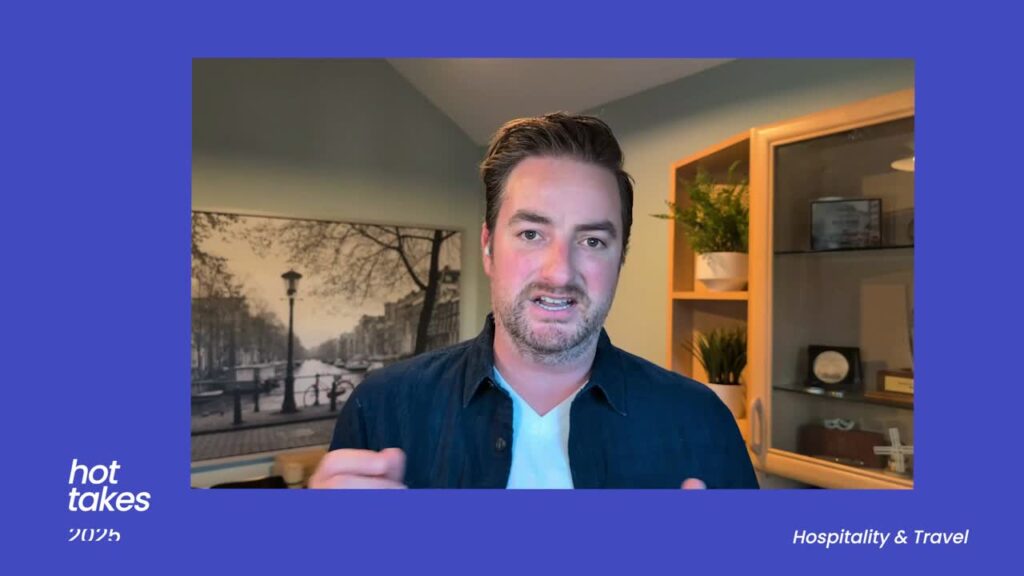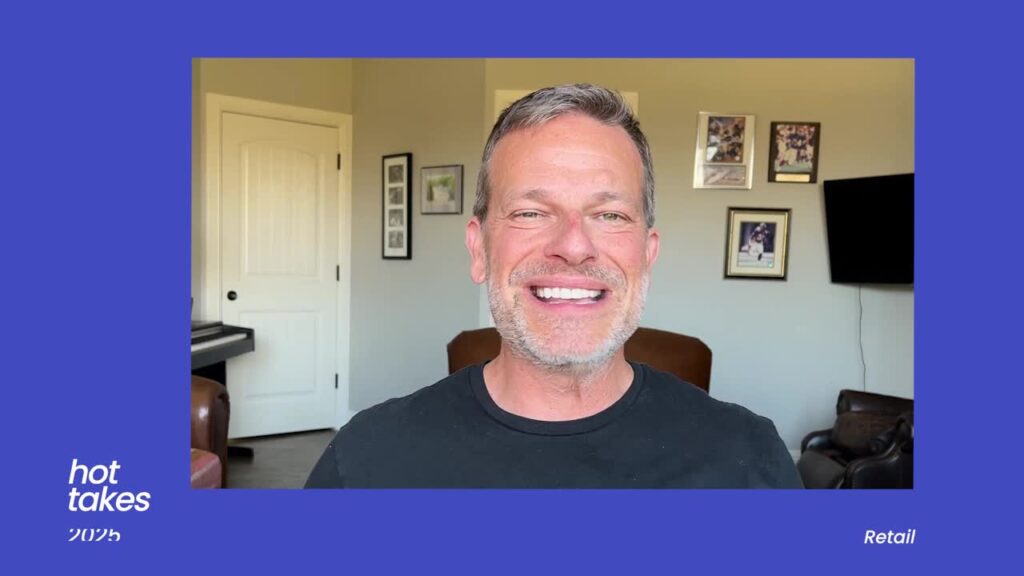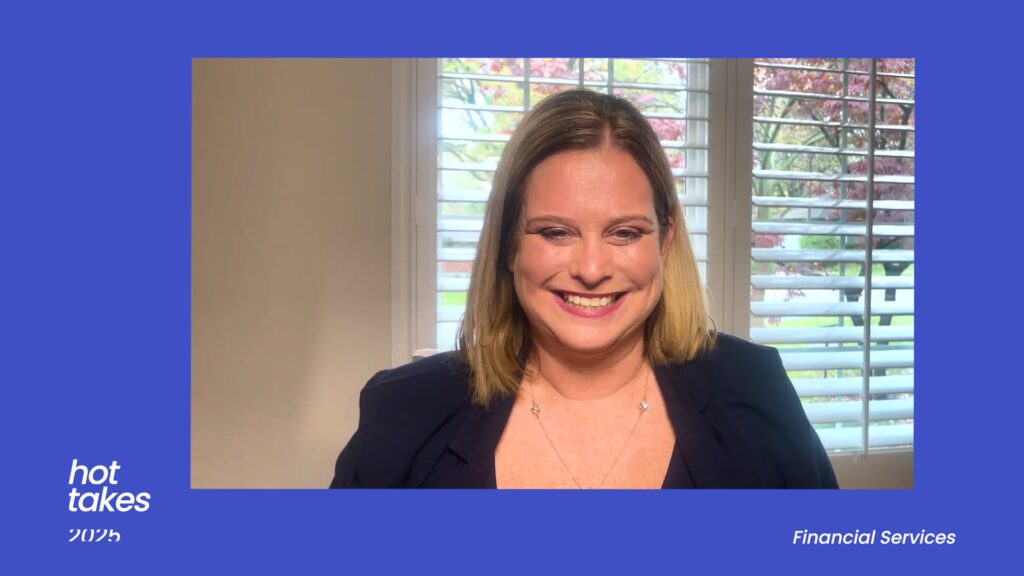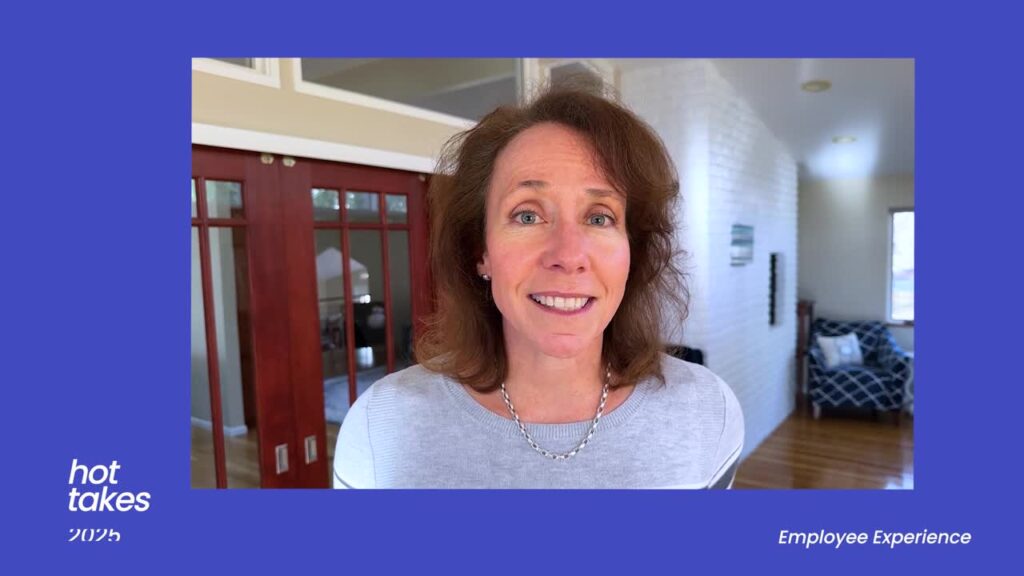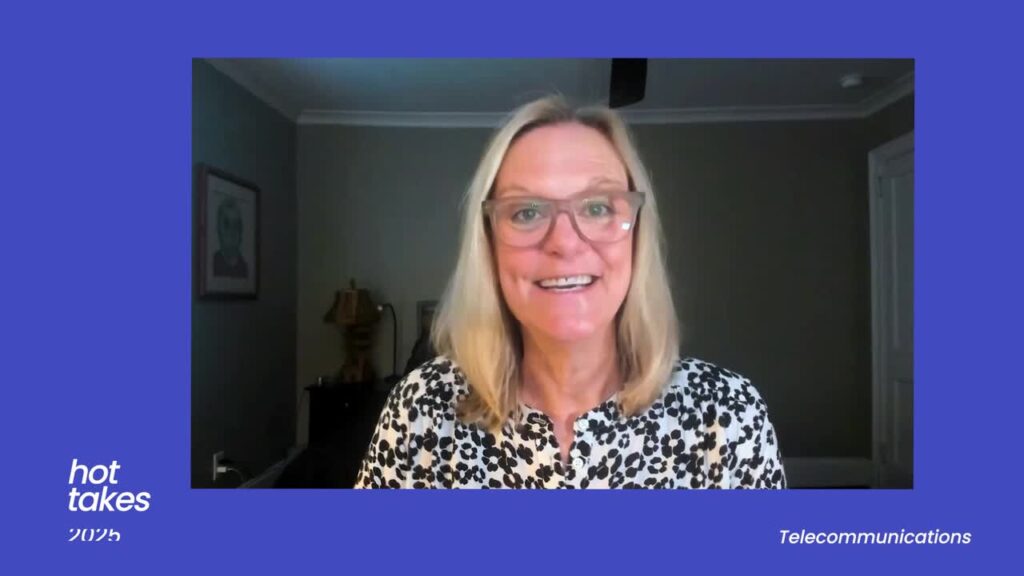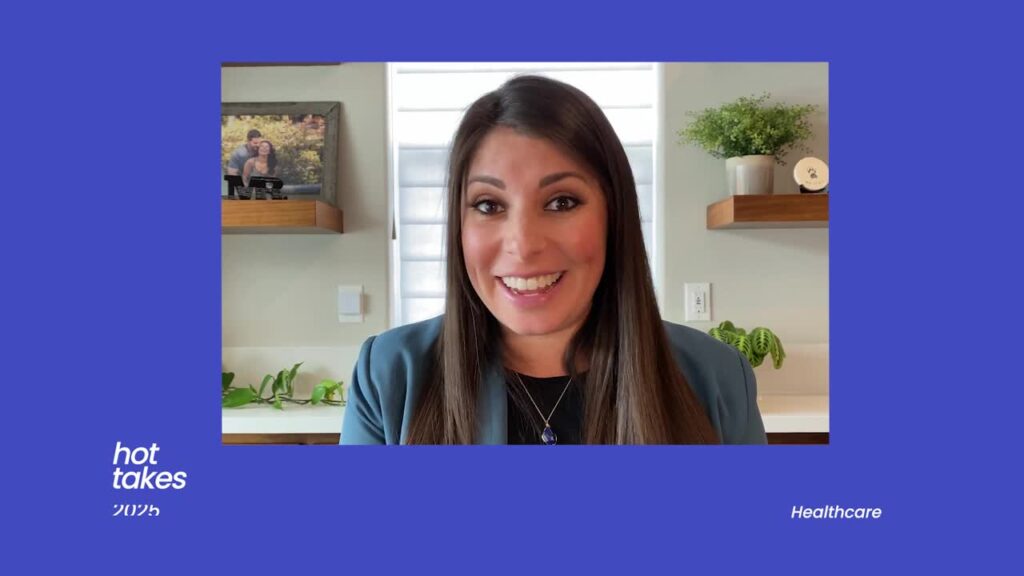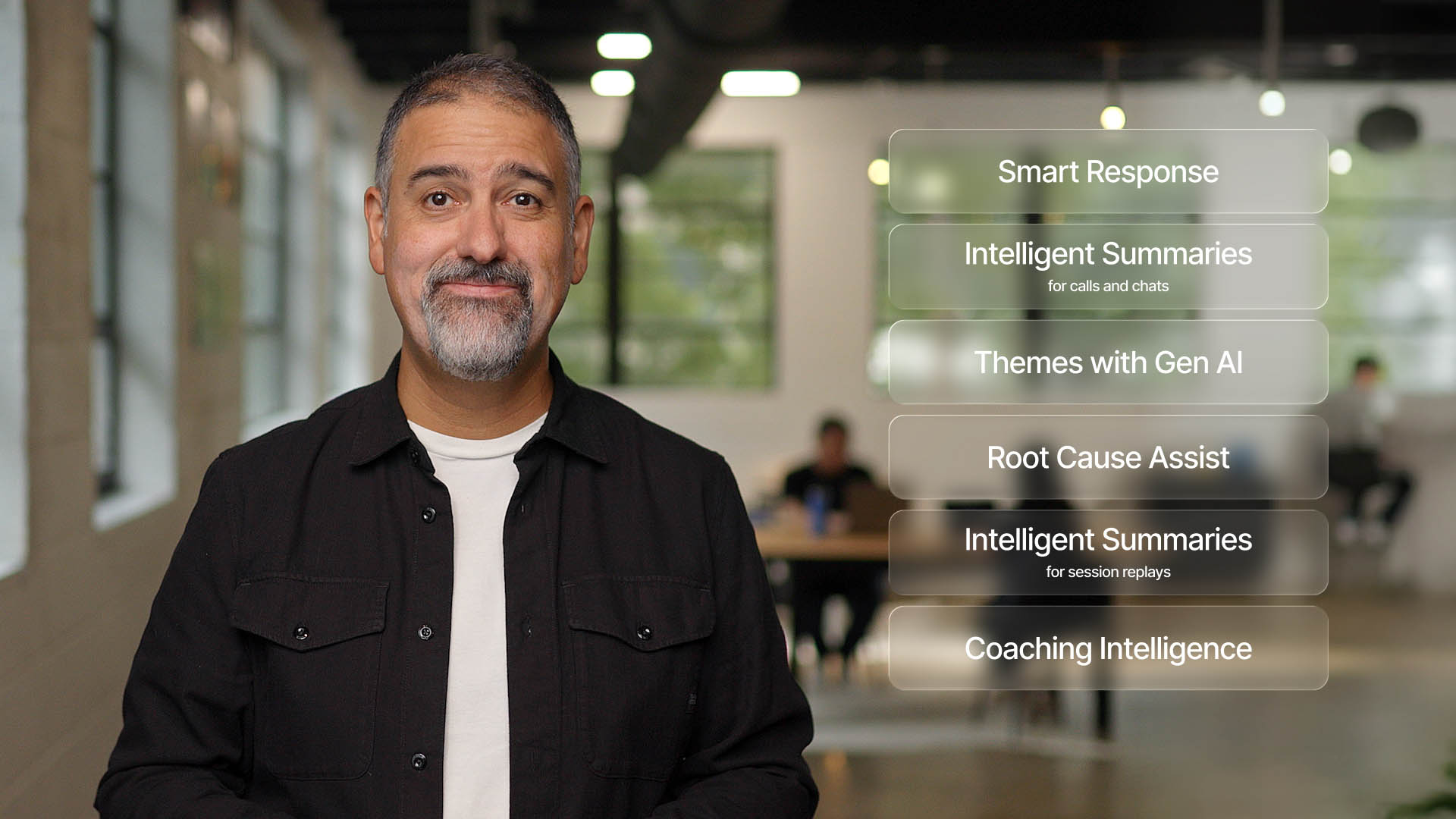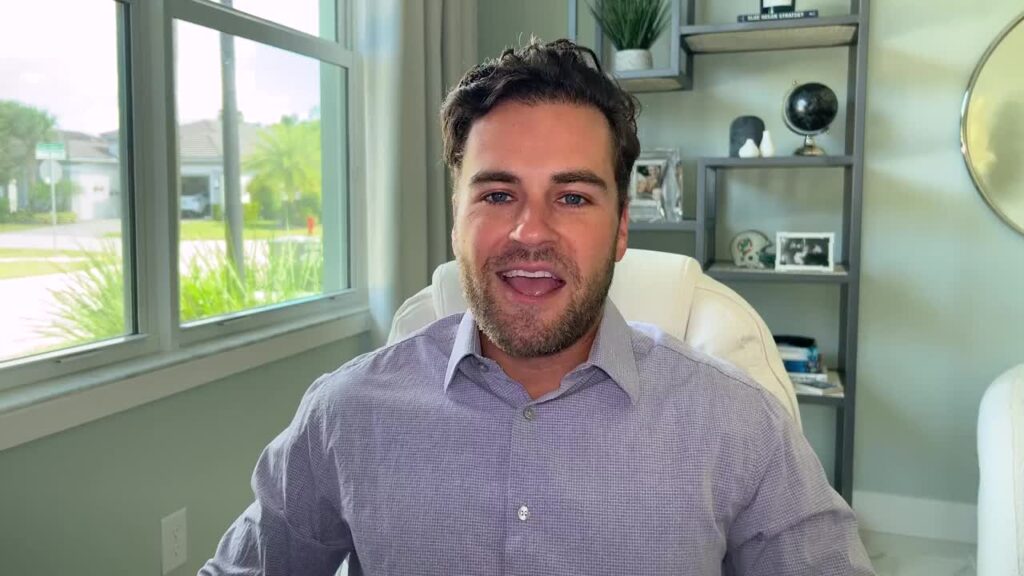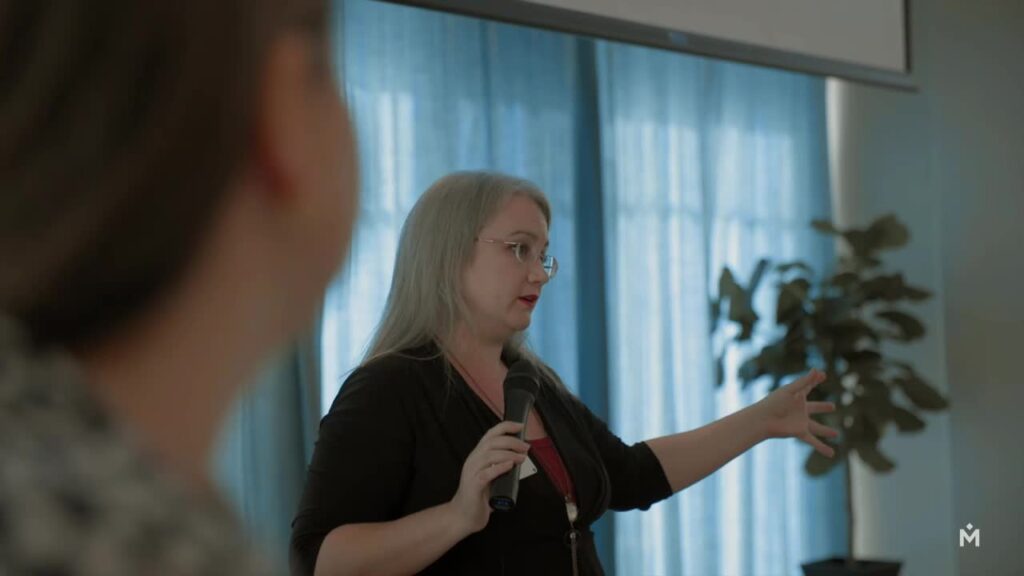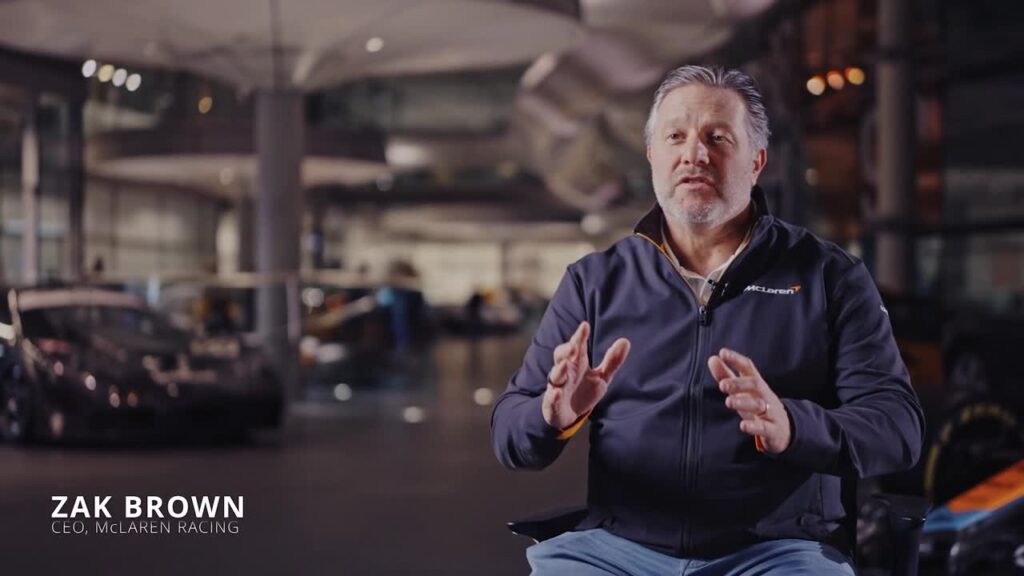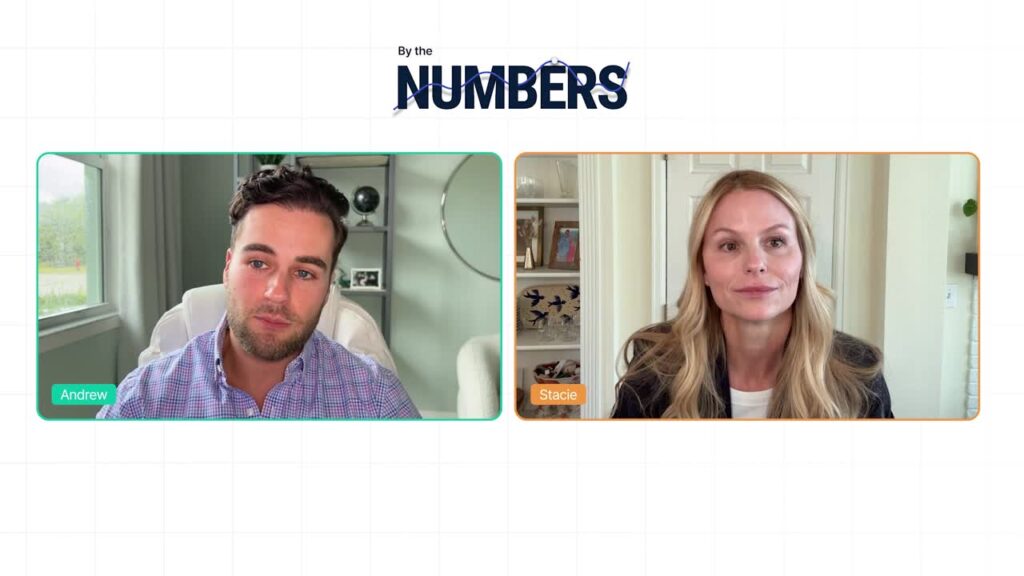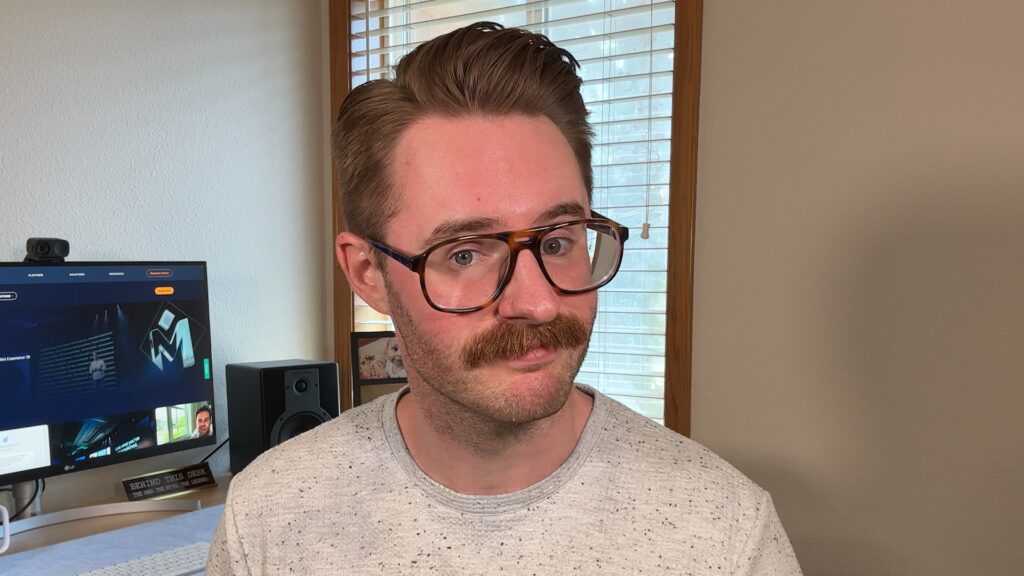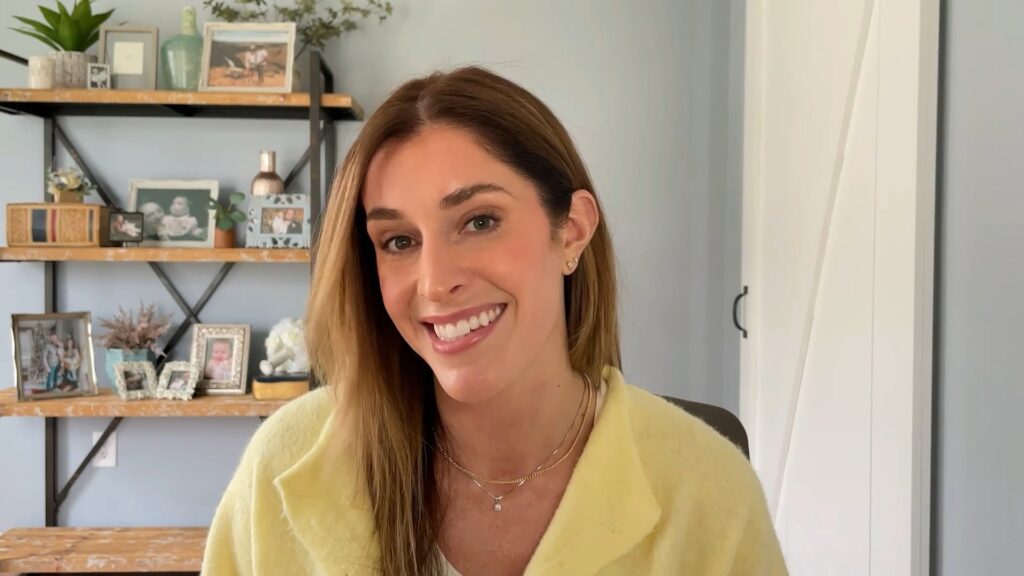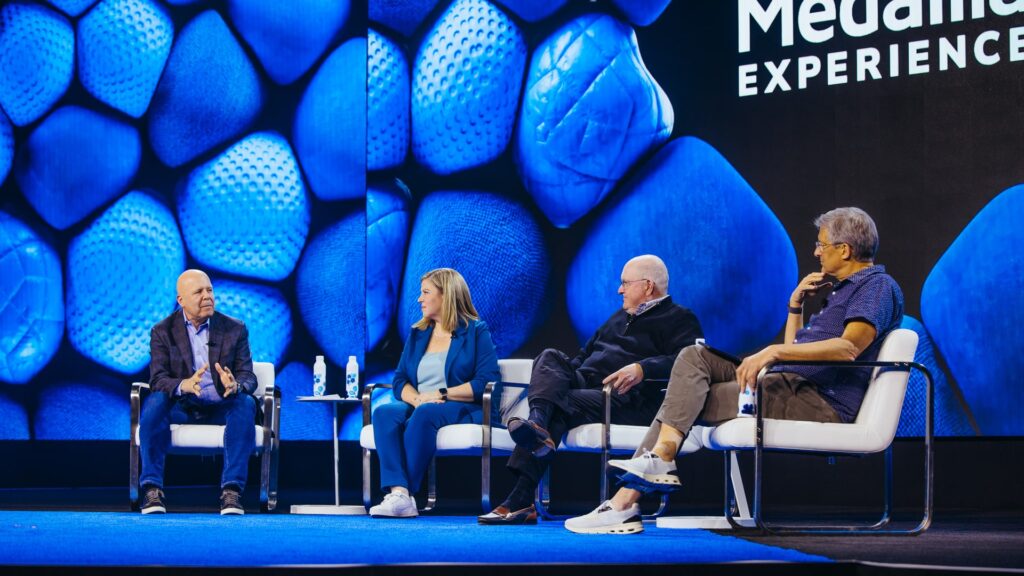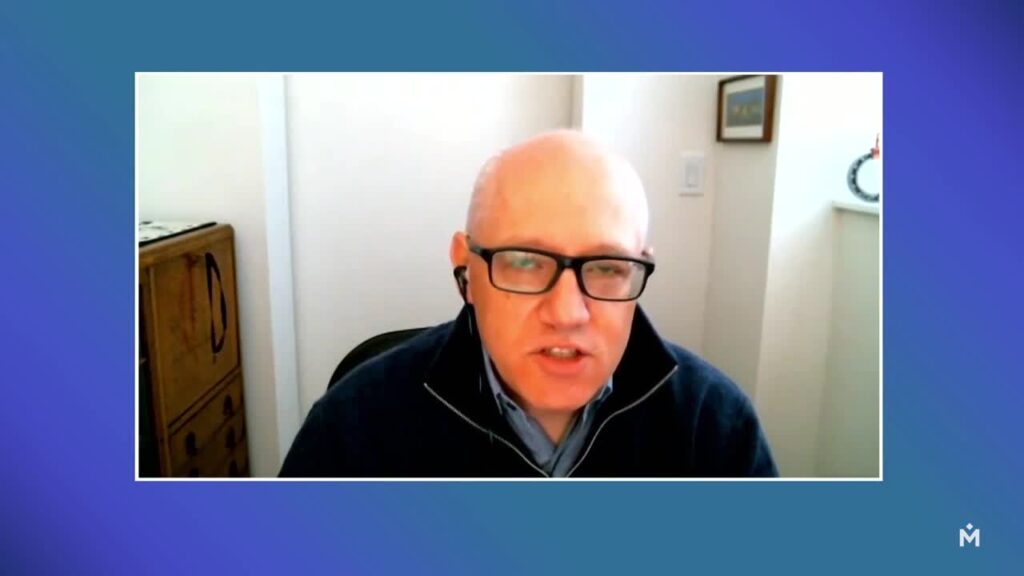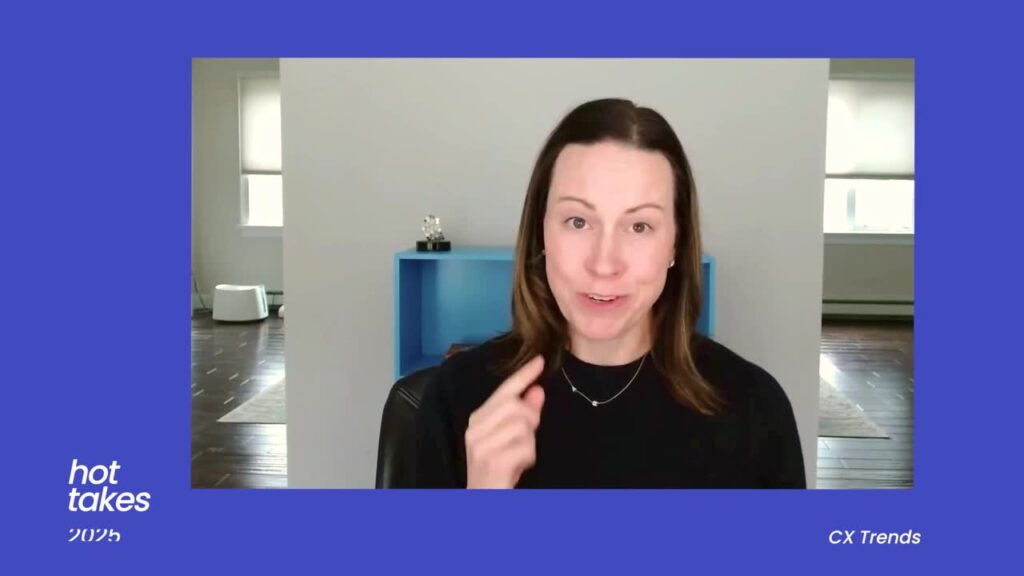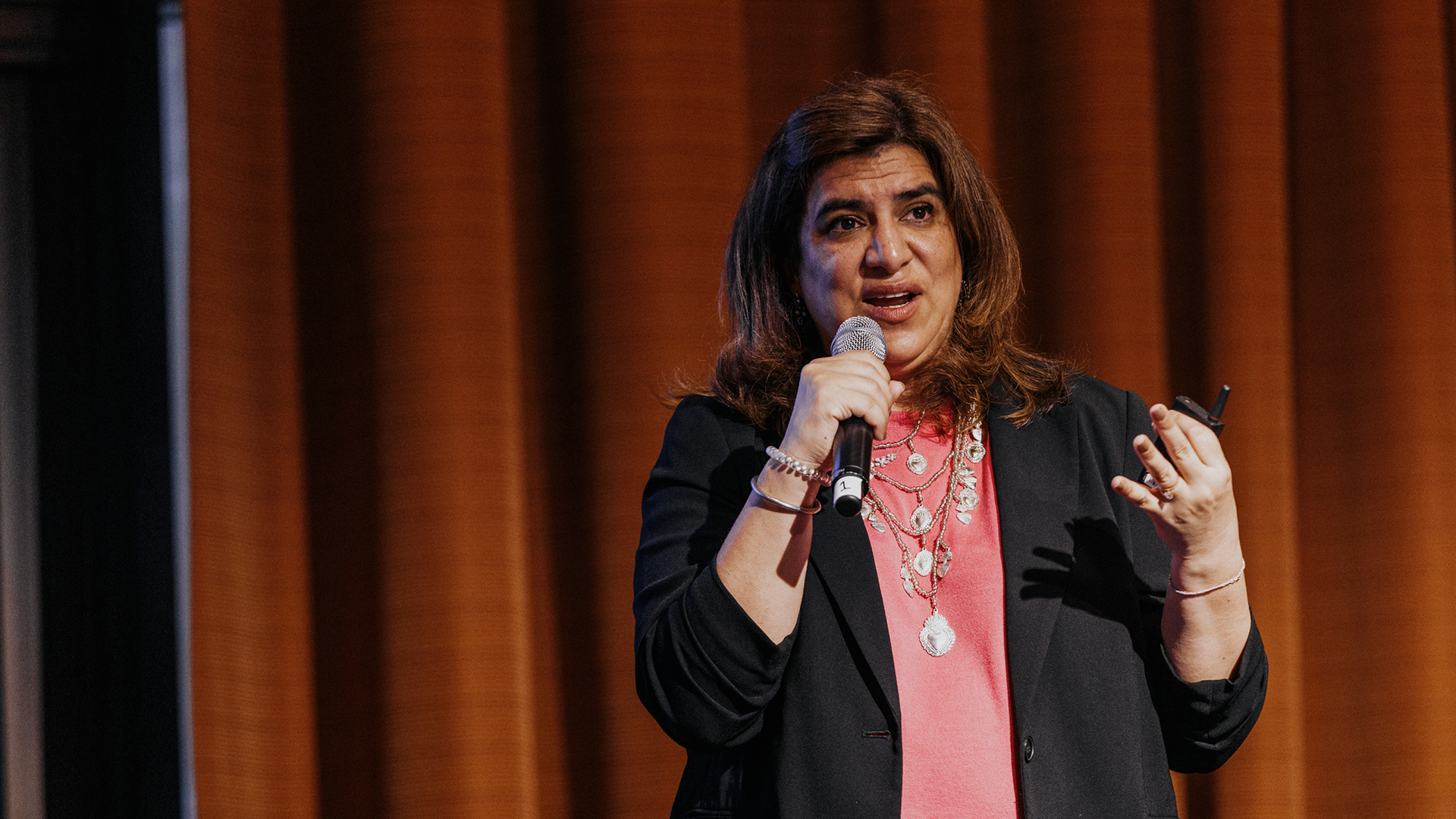Montserrat Padierna: [00:00:00] Thank you for being here. Thank you. Thank you for having the time. I know that after lunch probably is always, a challenge, but I really appreciate your time and interest. We’re here to share a little bit about us. It is a pleasure to be here. Thank you very much to the Medallia, Mexico, and US team for the invitation.
And again, thank you for listening. We’re here to learn as well from you. We’re here to network and we’re here to share a little bit of what we’re doing and of what’s been the latest journey in Walmart, Mexico, and Central America towards the customer experience. My name is Monza. I have been in Walmart the past eight years, and for the last two years I’ve been very fortunate to do what I love most, which is know the customer, reconciliate customer needs with business priorities.
We also represent not only our customers in our. Physical stores or digital stores. We also have [00:01:00] members with Sam’s and of course our associates. I am part of area called the customer office, and I have the privilege to lead the customer knowledge and experience team. Our role is exactly that.
How do we really translate? Customer or member data into insights, right? And how does that, how do we bring it to results? How do we measure them? How do we maximize? So it is a virtus cycle that we are currently doing, and our role is to influence across all the organization with all this.
Information of how we can do better. And we do that across more than our 3000 stores in Mexico clubs and again, or our digital channels. 60 years ago, Walmart was founded with a customer-centric mindset. Mr. Walton was right. Many of his concepts are very much alive. 40 years ago, we went into Walmart, [00:02:00] Mexico, however.
The past 10 years for Walmart, Mexico, and Central America have been amazing. We have undergone through a complete digital transformation effort in which. Our customers, our members, our associates are at the center of it. And today that’s what we are going to talk about, how we have been accelerating this path to become a much more customer-centric organization.
Having the NPS, having the experience at the center of it. Little bit of more context about Walmart, Mexico for so you have a better idea. What’s our organization? We are a little bit different in terms of a strategic offer. I’m gonna talk a little bit more about the traditional. We go beyond the traditional retail after the us, Walmart, Mexico, and Cam.
We are the second most important market. We are present in six different countries. And together we have almost 4,000 stores and clubs around the area. We are the number [00:03:00] one employer on these countries with over 280. Thousand associates, and we serve more than 6 million customers a day across all our channels.
So we do have an interesting footprint and a lot of responsibility into that. I mentioned we have some slight differences across our banners because we serve a big range of customers from the affluent segments. Two, towards a lower budget conscious one. We have six different banners, so we have Walmart, Mexico, of course, we have something similar to Walmart neighborhood, which is our Walmart express format.
Of course, we have Sam’s. But we also have another format in Mexico called Bodega Rera, who serves our most budget conscious customers, and in Central America it’s Pali. With that we really understand different and a broader [00:04:00] segments of customers and all of them have very unique and diverse needs, and that’s what we do.
We try to understand and go as fully as possible, aside from our physical and digital channels. We also are are offering services like what? For example, we have a mobile and internet company, so we are providing connections to our customers. We also have a health platform. With memberships, with healthcare solutions, we also have a financial services structure as well, and an engagement platform.
So more than brick and mortar, more than e-commerce. We are going into a, into the Walmart ecosystem, offering our customers, catering to our customer needs, most pressing needs and pain points. That’s what differentiate us within the region. That’s what differentiate us even inside our business, and it’s been proven.
Very interestingly, we have been learning a lot from [00:05:00] all those businesses. You may wonder 6 million customers a day. That’s a lot of customers. How well do we know our customers? Very much. Very much. Much that you imagine. And that is honestly because. The past two years, we have been going knee deep in getting to know them profoundly, deeply.
And of course one of the examples is the program that we’re gonna talk about, the experience management program that we will refer, I can probably say that we work together. With our extended team, of course our Medallia partners here. Thank you very much. Emelia Hill that you and all the team that is really supporting us.
And it’s interesting how deep we have gone into that. Do you know that more than 10 million Mexicans visit a supermarket every single day and about 2.2 million make online transactions from there? Would you like to guess how many transactions we have or are made [00:06:00] now? Omnichannel, physically and digitally.
Does anyone want to take a chance of how many? No. Ah, it’s more than a half. So our customers are really learning now to be much more omnichannel. And guess what? They are becoming very comfortable around us, precisely because we know that grocery shopping is one of the most common, mundane and necessary things right in life.
Who doesn’t do their grocery shopping, right? So we understand that it’s so essential for every household, for every person, and therefore we need to make this experience as seamless as enjoyable. I. As possible, right? But beware simple doesn’t mean boring or dull. And this is something that we are working a lot around.
We like to differentiate those dull moments and differentiate them through technology. How can we make them faster? How the, we can make it more agile. How can we make it more seamless? [00:07:00] Faster experience. Precisely. And there are some other moments that we love that we enjoy browsing, right? How can we potentiate that?
How can you really much more enjoy your time at the supermarket? Let’s talk a little bit about our customers. Again, I told you that we have different types of customers. We serve a broad range of them, so let’s talk a very simple segmentation that we like to follow and we like to share with us.
Let’s talk about first the price Sker. So this is our budget conscious customer, always looking for lower prices and looking for accessibility. These are our customers that really go into the basic basket, right? That. Most of them do not own a car, so they need to go on public transport, walking to our stores.
This is a very important base of our customers that, again, are catered by Bora or by Pali. Let’s talk about also the value seekers, right? These are the customers that are looking for a broader assortment. [00:08:00] They’re eager to maximize the value of their money. It’s essential for them to find everything in one single place.
Product services. This is a very important customer that is going very much online and showing a lot of omni-channel characteristics. The quality seeker, that’s an interesting one. He or she’s very most into experience, right? They are very focused in quality, in products, everything that has to do with fresh, and they’re looking for the best supermarket and the best vari variety customer service here.
It’s a priority. Service is very important, and let me share something with you. In our markets, this is becoming a very interesting and competitive dynamic. We are having very good competitors doing a lot of stuff into this terrain. So we better be good and excellent in the next months to come.
Every single day. And the wellness seeker, [00:09:00] has to do more for our members in the wholesale. They’re also, yes, they take care a lot of their money, but they’re also looking for novelties. They’re also looking for ways to be, surprised. They are very interested also in the variety and the benefits of the membership.
Each and one of them, of these customers have different needs, different pain points, and they need to be tackled. Served differently, and that’s what we do. We really go deep knee deep to understand what are those trigger points and how can we better cater to them and how we can work with our organization to be better every single day.
Again, we know that going to the supermarket can mean many things, right behind every card, every visit, there is a motivation that we trigger, a personal, a family need, and sometimes, we need to be there just to destress ourself, right to think. And that’s why we want to [00:10:00] provide our customers, and it’s very important, again, an easy, agile and intuitive shopping experience with, of course, always the best value equation that allows them to focus in what’s more important, their time, their family.
So that’s our job that, let me ask you, for you, what does grocery shopping mean? Hunger. Oh my god. Distraction. I like that. Nesting right. Necessity. Caring. Caring, of course. Yeah. They have so many different meanings, right? Parents looking for the perfect ingredients for a Sunday dinner person who wants to just to snack for a soccer match.
Every visit has a purpose, and our task is to turn that purpose into an experience that not only meets their specific needs, but also exceeds. Every single day. Their expectation. That’s the true challenge for us. [00:11:00] The repeat of the dynamic, we like to say that in Walmart, we are a company led by people, tech empowered, omnichannel retailer, dedicated.
To help people save money and time. A lot of buzzwords as well, right? Yeah. Very familiar to what we have been listening in the past few days. Again, the challenge for us, the challenge for our team isn’t just not to analyze numbers average or indicators or a lot of dashboards right behind every number.
We know there’s a reason that, or a signal that tell us, that speaks to us. Sometimes that shouts at us. Customer experience, right? And it’s not enough to know the reasons you need to go deeper. Why? Why is behind that? Deeply understand those reasons and how do that connect who they connect with the business, with the right part of the business and that allows us to take [00:12:00] action.
It doesn’t matter if you have a lot of information, if you cannot activate it. So when I talk about the team, I’m talking about the whole team. So we, you remember that I mentioned 280,000 associates. A lot of people in there, right? From the, of course, operational area, the financial, but again, these are the people that are in the frontline transforming the experience of customers and associates.
But we need to also understand that there, the value chain is way bigger, right? Supply chain. Accounting, hr, all of those people, all of those areas have a tremendous impact in our customer and members experience and our role is to clarify that across all the organization, we identify key pain points or key moments of satisfaction generated on each episode of the journey.
And then we go back and share that with them and activate them. How do we make this possible? How can we bring it to scale? [00:13:00] That that, that’s been the interesting channel. Our mission is clear. We help a lot of Mexicans, a lot of Mexicans and Central America. And the best way to do this, we do it this daily, week by week.
We use this information in our most basic and integrated. Meetings we share to a level of detail in which our inter, our key stakeholders can understand not only the score, the reasons behind it. We like to call them levers. And these levers have, a tier two, a tier three, profound and deep insight to understand exactly what is moving the NPS, what is contributing positively or negatively.
Every single week. I will share this with you. Seven years ago, the first NPS data arrived to our company. And of course at that time it was completely negative. But let’s not focus on that. Let’s focus [00:14:00] on where it was. It was a numbered, buried in one of many of the reports from our operational team.
When we asked, what does this number means, what does it do for you? I don’t know. I just know it’s there. Okay, so you don’t know how to use it. No, I know it’s there and sometimes they ask us for it, but I don’t know how does this works for me. And you can imagine how appalling for us, I.
That was that there were some stores that, interestingly, they had skyrocket mps that you could not imagine that they were there. We found out that there were a lot of people, pushing into those surveys, right? And so it was not useful at all. So we thought that it was something that we, it was matter to go deep enough, right?
And there was our quest to really prove. The organization to really understand what was the need of that, and that’s how [00:15:00] we got to work to be, honestly, I. We went deep again to understand what was behind the NPS. What causes positivity or negativity, how do we contribute to the score? We reinvented the, a whole way of how do we ask our customers or members for feedback, right at the right place, at the right channel.
We adapted to their habits. Right before my talk, there was one from Capital One and they were talking a lot about that. Where is the right moment to ask for your customers? And then we started to generate and to go deep into that knowledge to really understand it into another level. Day. We began to understand more clearly their thoughts and every moment of their shopping journey in our stores, in our websites, in our calls.
We learned to explain it and connect it to the business. That was a huge challenge. How does that, all those data points made sense to our business, to our [00:16:00] leaders to our frontline, completely different types of audiences and priorities and languages. We learned to talk to our cashiers, but also to our people supporting the operation.
Think about forklifts. Think about asset protection personnel. Think about admin personnel, completely different and that was changed the paradigm, to be honest with you. We are, we realize that constant and deep feedback involves every single one in the company. We are all responsible for the omnichannel experience for our customers and members.
Simple. But completely has changed how we work inside of Walmart, Mexico, and Central America. The customer experience be begins in the moment that is triggered. The idea of, I need to buy this, I need to buy that. And then of course it come, they come into our stores, they go into our websites or apps and we follow them.
It never finishes, [00:17:00] to be honest, right? You need to receive your goods, you need to, you go back to your home with your groceries and then. Were you happy? Was it was you were looking for? Did you need additional support? And then the cycle goes back again. So this is something that we like to share with this end-to-end vision.
And again, every single one in the company has a role in that. Let me share this with you. Let’s take it a little bit closer. So we like to understand the NPS and the customer experience are at the core of this experience management platform that, that we’re looking for. It’s a universal language that.
Many in the company are starting to talk. That helps us to really convey specific concepts. So the customer experience for us, it’s divided into the front stage, and we like to look at the inner loop or the backstage, where, which is the outer loop. We talk about four important actions.
Everything has to do with visibility and feedback to our stakeholders all the time. So [00:18:00] I talk to you that every single week we share this into a lot of detail, to all our banners, to all our channels and stakeholders, accessibility. We provide all the tools, all the needs, all the training.
There’s a lot of training that we need to do, and we work very closely with our change management and culture teams on that. We also talk about ownership. Ownership definition of how to make decisions. So aside from the data, how can they make it to work? How can really they impact on a monthly, weekly, yearly se each semester.
With this information and finally, the triage, right? It’s very important to, to connect this with other scores, with other metrics, with the business. How does that impact their specific goals? That’s very important. With this we work a lot and we work across an information ecosystem. We’re working very hard on this.
Not perfect, but it, this is something that we are looking for. [00:19:00] We like to think that our customers, as of today, most of our surveys are done through qr. Some others go directly by email, and we have been working a lot with messages, a lot of things, trying to understand how we can. Get better, at feedback, right in the right moment.
We also like to understand that there are short term activities, things that we can do from one day to another, and it’s easy to do. We like to share that specifically to our operational team, and we’ve seen a positive cycle because every time they’re reacting to that. The operational metrics move and they start to see positive results.
So this is something that we are trying to do constantly on every day. We work also with a lot of alerts. Those customers that we do not serve correctly, how can we really tap into them as quickly as possible and solve. Positively, right? We like to also integrate listening, right? Everything that comes [00:20:00] from our call centers with the same logic, how all this as a voice of the customer program is integrated and really help us to understand what are those levers of the need.
This system is embedded in our team and places the customer, again, in the center, not only on us in all our associates. Again, I mentioned to you the NPS has evolved from that single point of data, an ongoing process of understanding, managing, and enhancing our omnichannel experience. It’s a core process now.
It’s one of our North Star metrics that many have in their own scorecard, and that has helped us a lot. That has been pivotal for us, the adoption. Some numbers. We receive more than 10 million surveys a year across all our channels. We integrate that in this omnichannel customer lease and ecosystem that I was referring to.
We have 70,000. Active users [00:21:00] that connect to understand the importance of the NPS. And that has allowed us to have a common language. We have 46 standardized NPS programs across the region. So that is amazing because we have been able to. Share in a common language, how do we measure, how do we read it, right?
So I have to tell you, I have to share this. So every time that we go into the store and be able to talk to a frontline manager or it’s amazing to, to learn from them how they are really leveraging the, these insights. We are very focused on understand again, what is behind it. So we’re starting to see patterns across regions across types of customers, across the times of the day.
We are starting to understand and to correlate also emotions. What are emotions are triggered in there, right? And where exactly in the loop. Does that make sense for us? We are definitely on constant evolution, always. Working [00:22:00] together. We work very much with our data and product team ar around this to integrate a lot of this data to fit in, to create new products, to change our processes.
We have been working a lot to make it available, transparent, all these data to, to all our associates as fast as possible. As easy to understand. We have a lot of things that we need to do there, but we are on that. So offices, stores, everybody. We’re starting to speak the same language. Again, during the past year and a half, we are working very collaboratively with our, with Central America, with other countries within Walmart International and scaling it through commercial eCommerce operations.
And again, Medallia, thank you for helping us on this quest. This is a good view of this would be if you would go to any of our stores. This is a handheld. That they have. And you would see there how they we’re integrating all this feedback [00:23:00] inside their own language, their own way of seeing things and they can really understand their store, why the NPS is moving, what are those levers?
What are the reasons behind it? And that’s give, gives a lot of power and visibility. Our goal is to keep on doing much more of this. Our priority, of course, we’re frontline managers, but now we’re working on different views for our other users. We are working here on a different way of talking to people, and it’s been interesting enough that now they are not as focused in the number.
They are focused in the why. And how that, that why is really helping the business on a daily or in a weekly basis. So now we’re all co-responsible for this customer experience and everybody knows what to do. I think that’s important. I. Again, I referenced that and I believe that what we have been talking in the last days about, turning data into insights, into [00:24:00] actions, into recommendations, measure them and results.
We’re trying to do this with all this process, and we will keep evolving around this. We’re working this as a enhanced experience that again, we share with all of our key stakeholders inside our company. We can proudly say that seven out of 10 customers are happy with us, they like to shop with us.
However, we do not forget that those three, we have not yet served correctly. We have not yet won over, and we want to continue to earn their trust and satisfaction. We’re measuring customer experience. Through numbers, through technology. But also, again, I, and I mentioned this through emotions, we want to go much more deeper in terms of understanding.
We like to solve, we want to adapt to their needs. And I, that’s where we think that technology is amazing. That’s where we’re starting to leverage a lot of AI agents that we are learning here and [00:25:00] from others, but also again. Triggering human or enhancing human needs, right? We are that, that are created in each interaction.
NPS is really transforming the way we work, the way we measure, the way we connect with our customers and members. At the end of the day, everybody is responsible for the customer experience. So again, let’s keep us moving forward. Let’s keep creating great experience and improve every single day.
Finally, four things, four key lessons that I would like to share with you that have been very important for us implementing this customer centric. Model first, we are not talking about improving customer, just talking about customer experience. We’re talking about a profound change, a change that begins with a total alignment across all the company.
A change that, yes, of course, is pushed by our C-suite, by our CEO, but a [00:26:00] change that needs to happen on. An individual level, every single executive or associate in the stores, everybody must be synchronized to fulfill their admission. Put the customer at the center of everything we do beyond words with actions.
Second of all, the MPS, again, it’s no longer an isolated number. It has become an experiential and management process. We continue to work every piece of the data, every piece of the feedback. It’s an opportunity for us, an opportunity for action because we do not just measure and measure, we act and improve, and that has become very important to us in the last couple of years.
Third, this process requires collaboration work with other areas. Again, I mentioned change management and culture, but also, other teams, our marketing teams, our infrastructure, our operations, those decisions. Impact and all these teams have to be together on that. [00:27:00] So they have been pivotal for us in this process.
How do we work together and how do we make sure that everything that we are producing is useful for them? We need to keep on creating memorable experience in conjoint, and it’s a job that involves all of us every single day. And last but not least, we have also become an agent of change. Our role is not only to be COE leaders, our role is to really model in these tables, really talk much more about this customer centricity culture.
Our responsibility is to have an impartial, an agnostic voice that drives real change for our customers, for our members, for our associates. Be brave. Be very brave about what you’re going to be saying on those tables. Of course, you need to be. Very well informed. You have to be very prepared. But most importantly, you need to be straightforward and brave.
Turn this into action, [00:28:00] and we ensure that the customer needs are really well represented on that. So kudos to the team doing that, eh, and again, if we don’t do that. Others will be doing that. This is a moment that we have been living for many years now. Now more than ever. There’s a lot of key points and, touch points that our customers and they, again, there are a lot of great experiences created.
From a lot of your industries. So our customers are becoming a little bit, they’re asking way much more from us, so we need to keep on that. So let’s keep on doing that. Make our customers feel at home. Feel comfortable. Let’s excel on this. Thank you very much for your time.
I think we have around. Five minutes for questions. Okay.
Q+A: Hi my name’s Alex and I’m with [00:29:00] MGM Grand in Detroit. Hello, Alex. Hi. Great presentation Question is you mentioned having 46 MPS programs. Yes. Can you give an example of one of those and how it impacts the guest experience positively.
In what ways?
Montserrat Padierna: Okay. So when we talk about this I mentioned that we have banners, right? And these NPS have this program has levers, eh, quality price, eh, time at checkout. Those are basic ones, right? But we have different customer value propositions for these banners. And let’s talk about, Sams would be this wellness seeker that is looking what’s important for that customer?
Probably some kind of assortment price. They’re not as price conscious as others, but availability is important. [00:30:00] So we make like tailor made suits for these banners or channels with these levers and they, and we can go like knee deep up to two or three levels that are very specific, right? So now we know that if we do not get a.
Positive NPS score. We know that probably this member was in XCL and she was not happy. Probably about produces, right? And the problem with produces was that apples were not fresh enough. We can go into that level and that is translated directly to the banners. So it’s way much more direct and we cannot only share that information with our banners.
We can also talk to our merchant team, Hey, we have an issue here, right? Even to our supply chain team. And I am trying to put you, to talk about a very specific example. Funny things comes when we [00:31:00] talk about a service, right? Was the associate friendly? Was the associate there on time to help you?
There’s a lot of fun stuff and conversations that we have in on that front. Thank you for your question, Alex.
Q+A (2): Hi, I am Michelle Lee from Apple retail actually. So a lot of this resonates a lot with our program as well. I was wondering, when you share the data with your associates what level of detail are you giving them?
And I. What actions are they taking out of it? I was just wondering if it’s more individual or team level or operational.
Montserrat Padierna: Listen to a manager. This is the one that we were sharing. We can share exactly, eh, again, in those, these levers, cleanness service, those kind of things, their specific store.
Let’s say, let’s talk about service. This lever around service is contributing negatively to the NPS. Why? Okay, [00:32:00] now we know that because, eh, during the weekdays on peak hours, I. Where we have X amount of associates within the store, they are not being friendly. Our customers are feeling not seen, taken care of.
They can track specifically who was on the store, what was happened, how many people were in there, and then action towards that. We can do this in store level, club level, but we also do it in regions, cities, banner segments of stores. So we, we can arrange the data with different points of view and again, like our key stakeholders have started to go knee deep into those and, going very deeply and everybody is starting to have their own mitigation process in order to enhance.
NPS scores week by week. Thank you for your time. Thank you for being here. I hope you keep enjoying the Medal Experience Team. See you [00:33:00] soon.

